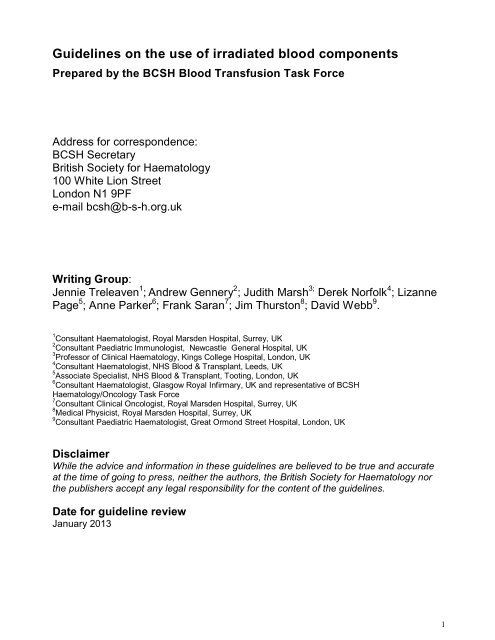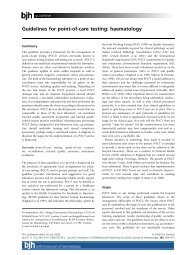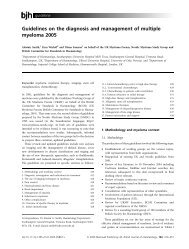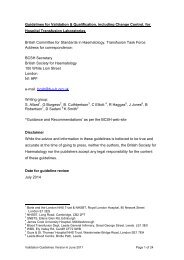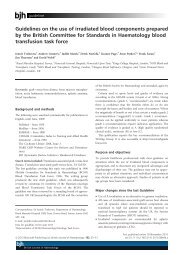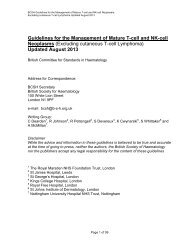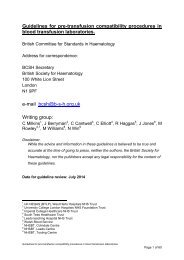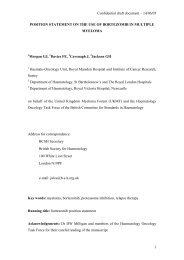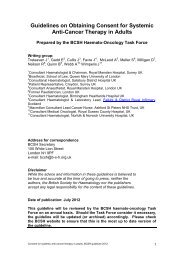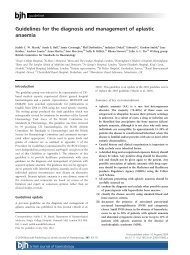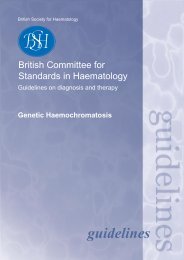Guidelines on the use of irradiated and leucodepleted blood products
Guidelines on the use of irradiated and leucodepleted blood products
Guidelines on the use of irradiated and leucodepleted blood products
You also want an ePaper? Increase the reach of your titles
YUMPU automatically turns print PDFs into web optimized ePapers that Google loves.
<str<strong>on</strong>g>Guidelines</str<strong>on</strong>g> <strong>on</strong> <strong>the</strong> <strong>use</strong> <strong>of</strong> <strong>irradiated</strong> <strong>blood</strong> comp<strong>on</strong>ents<br />
Prepared by <strong>the</strong> BCSH Blood Transfusi<strong>on</strong> Task Force<br />
Address for corresp<strong>on</strong>dence:<br />
BCSH Secretary<br />
British Society for Haematology<br />
100 White Li<strong>on</strong> Street<br />
L<strong>on</strong>d<strong>on</strong> N1 9PF<br />
e-mail bcsh@b-s-h.org.uk<br />
Writing Group:<br />
Jennie Treleaven 1 ; Andrew Gennery 2 ; Judith Marsh 3; Derek Norfolk 4 ; Lizanne<br />
Page 5 ; Anne Parker 6 ; Frank Saran 7 ; Jim Thurst<strong>on</strong> 8 ; David Webb 9 .<br />
1<br />
C<strong>on</strong>sultant Haematologist, Royal Marsden Hospital, Surrey, UK<br />
2<br />
C<strong>on</strong>sultant Paediatric Immunologist, Newcastle General Hospital, UK<br />
3<br />
Pr<strong>of</strong>essor <strong>of</strong> Clinical Haematology, Kings College Hospital, L<strong>on</strong>d<strong>on</strong>, UK<br />
4<br />
C<strong>on</strong>sultant Haematologist, NHS Blood & Transplant, Leeds, UK<br />
5<br />
Associate Specialist, NHS Blood & Transplant, Tooting, L<strong>on</strong>d<strong>on</strong>, UK<br />
6<br />
C<strong>on</strong>sultant Haematologist, Glasgow Royal Infirmary, UK <strong>and</strong> representative <strong>of</strong> BCSH<br />
Haematology/Oncology Task Force<br />
7<br />
C<strong>on</strong>sultant Clinical Oncologist, Royal Marsden Hospital, Surrey, UK<br />
8<br />
Medical Physicist, Royal Marsden Hospital, Surrey, UK<br />
9<br />
C<strong>on</strong>sultant Paediatric Haematologist, Great Orm<strong>on</strong>d Street Hospital, L<strong>on</strong>d<strong>on</strong>, UK<br />
Disclaimer<br />
While <strong>the</strong> advice <strong>and</strong> informati<strong>on</strong> in <strong>the</strong>se guidelines are believed to be true <strong>and</strong> accurate<br />
at <strong>the</strong> time <strong>of</strong> going to press, nei<strong>the</strong>r <strong>the</strong> authors, <strong>the</strong> British Society for Haematology nor<br />
<strong>the</strong> publishers accept any legal resp<strong>on</strong>sibility for <strong>the</strong> c<strong>on</strong>tent <strong>of</strong> <strong>the</strong> guidelines.<br />
Date for guideline review<br />
January 2013<br />
1
1. Background <strong>and</strong> Methods<br />
The following were searched systematically for publicati<strong>on</strong>s in English, until June, 2009:<br />
PubMed - from 1950<br />
Medline - from 1950<br />
EMBASE - from 1980<br />
CINAHL (Cumulative Index to Nursing <strong>and</strong> Allied Health Literature) - from 1982<br />
The Cochrane Library 2008, Issue 3<br />
DARE CRD Website (Centre for Reviews <strong>and</strong> Disseminati<strong>on</strong>)<br />
SRI (Systematic Review Initiative) H<strong>and</strong>search Databases<br />
The last guideline covering this topic was published in 1996.The writing group produced <strong>the</strong><br />
new draft guideline which was subsequently revised by c<strong>on</strong>sensus by members <strong>of</strong> <strong>the</strong><br />
Haemato-<strong>on</strong>cology <strong>and</strong> Blood Transfusi<strong>on</strong> Task Forces <strong>of</strong> <strong>the</strong> British Committee for<br />
St<strong>and</strong>ards in Haematology (BCSH). The guideline was <strong>the</strong>n reviewed by a sounding board<br />
<strong>of</strong> approximately 100 UK haematologists, <strong>the</strong> BCSH <strong>and</strong> <strong>the</strong> committee <strong>of</strong> <strong>the</strong> British<br />
Society for Haematology <strong>and</strong> amended, again by c<strong>on</strong>sensus.<br />
Criteria <strong>use</strong>d to quote levels <strong>and</strong> grades <strong>of</strong> evidence are according to <strong>the</strong> GRADE system<br />
(Guyatt, et al 2006). Str<strong>on</strong>g recommendati<strong>on</strong>s (grade 1, 'recommended') are made when<br />
<strong>the</strong>re is c<strong>on</strong>fidence that <strong>the</strong> benefits ei<strong>the</strong>r do or do not outweigh <strong>the</strong> harm <strong>and</strong> burden <strong>and</strong><br />
costs <strong>of</strong> treatment. Where <strong>the</strong> magnitude <strong>of</strong> benefit or not is less certain a weaker grade 2<br />
recommendati<strong>on</strong> ('suggested') is made. Grade 1 recommendati<strong>on</strong>s can be applied<br />
uniformly to most patients whereas grade 2 recommendati<strong>on</strong>s require judicious applicati<strong>on</strong>.<br />
The quality <strong>of</strong> evidence is graded as A (high quality r<strong>and</strong>omised clinical trials), moderate<br />
(B) or low (C).<br />
This publicati<strong>on</strong> reports <strong>the</strong> key recommendati<strong>on</strong>s <strong>of</strong> <strong>the</strong> Writing Group. The full versi<strong>on</strong> <strong>of</strong><br />
<strong>the</strong> guideline, including background informati<strong>on</strong> <strong>and</strong> full references is accessible <strong>on</strong><br />
www.bcshguidelines.com.<br />
2. Purpose <strong>and</strong> Objectives<br />
To provide healthcare pr<strong>of</strong>essi<strong>on</strong>als with clear guidance <strong>on</strong> situati<strong>on</strong>s when <strong>the</strong> <strong>use</strong> <strong>of</strong><br />
<strong>irradiated</strong> <strong>blood</strong> comp<strong>on</strong>ents is appropriate, <strong>and</strong> to document any recognised advantages<br />
<strong>and</strong> disadvantages <strong>of</strong> <strong>the</strong>ir <strong>use</strong>. The guidance may not be appropriate in all patient<br />
situati<strong>on</strong>s, <strong>and</strong> individual circumstances may dictate an alternative approach. Studies <strong>of</strong><br />
patients in all age groups have been c<strong>on</strong>sidered.<br />
3. Major changes since <strong>the</strong> last Guideline<br />
� Use <strong>of</strong> X-irradiati<strong>on</strong> as an alternative to gamma irradiati<strong>on</strong><br />
� All cases <strong>of</strong> transfusi<strong>on</strong>-associated graft-versus host disease <strong>and</strong> all episodes where<br />
n<strong>on</strong>-<strong>irradiated</strong> comp<strong>on</strong>ents are transf<strong>use</strong>d to high risk patients should be reported to<br />
nati<strong>on</strong>al haemovigilance systems (in <strong>the</strong> UK, <strong>the</strong> Serious Hazards <strong>of</strong> Transfusi<strong>on</strong><br />
[SHOT] initiative)<br />
2
� Irradiated comp<strong>on</strong>ents are recommended for all patients receiving<br />
immunosuppressive <strong>the</strong>rapy with anti-thymocyte globulin (ATG)<br />
� Indicati<strong>on</strong> for <strong>irradiated</strong> comp<strong>on</strong>ents extended to newer purine analogues <strong>and</strong><br />
related drugs until evidence <strong>of</strong> <strong>the</strong>ir safety is forthcoming (eg bendamustine <strong>and</strong><br />
cl<strong>of</strong>arabine)<br />
� Irradiated comp<strong>on</strong>ents indicated for patients receiving <strong>the</strong> biologic<br />
immunosuppressive agent alemtuzumab (anti-CD52), but not rituximab (anti-CD20)<br />
– regular review will be needed as new biologic agents enter clinical practice<br />
4. Summary <strong>of</strong> Key Recommendati<strong>on</strong>s<br />
� All cases <strong>of</strong> transfusi<strong>on</strong>-associated graft-versus-host disease (TA-GvHD)<br />
should be reported to <strong>the</strong> nati<strong>on</strong>al haemovigilance system as should all<br />
„near misses‟ where n<strong>on</strong>-<strong>irradiated</strong> comp<strong>on</strong>ents are transf<strong>use</strong>d to high-risk<br />
patients without incident (1B)<br />
� Gamma or X-irradiati<strong>on</strong> <strong>of</strong> <strong>blood</strong> comp<strong>on</strong>ents, by validated systems, is <strong>the</strong><br />
recommended procedure to prevent TA-GvHD (1B)<br />
� The minimum dose achieved in <strong>the</strong> <strong>irradiated</strong> volume should be 25 Gy, with no<br />
part receiving more than 50 Gy (1B)<br />
� For at-risk patients, all red cell, platelet <strong>and</strong> granulocyte c<strong>on</strong>centrates<br />
should be <strong>irradiated</strong> except cryopreserved red cells after deglycerolizati<strong>on</strong>. It<br />
is not necessary to irradiate fresh frozen plasma, cryoprecipitate or<br />
fracti<strong>on</strong>ated plasma <strong>products</strong> (1B)<br />
� All d<strong>on</strong>ati<strong>on</strong>s from first- or sec<strong>on</strong>d-degree relatives should be <strong>irradiated</strong>, even<br />
if <strong>the</strong> patient is immunocompetent (1B)<br />
� All HLA-selected comp<strong>on</strong>ents should be <strong>irradiated</strong>, even if <strong>the</strong> patient is<br />
immunocompetent (2C)<br />
� Red cells may be <strong>irradiated</strong> at any time up to 14 days after collecti<strong>on</strong>, <strong>and</strong><br />
<strong>the</strong>reafter may be stored for a fur<strong>the</strong>r 14 days. Where <strong>the</strong> patient is at<br />
particular risk from hyperkalaemia, e.g. intrauterine or ne<strong>on</strong>atal exchange<br />
transfusi<strong>on</strong>, it is recommended that red cells be transf<strong>use</strong>d within 24 h <strong>of</strong><br />
irradiati<strong>on</strong> or that <strong>the</strong> cells are washed (1A)<br />
� Platelets can be <strong>irradiated</strong> at any stage during storage <strong>and</strong> can <strong>the</strong>reafter be<br />
stored up to <strong>the</strong>ir normal shelf life after collecti<strong>on</strong> (1A)<br />
� All granulocyte comp<strong>on</strong>ents should be <strong>irradiated</strong> before issue <strong>and</strong><br />
transf<strong>use</strong>d with minimum delay (1C)<br />
� Irradiated comp<strong>on</strong>ents not <strong>use</strong>d for <strong>the</strong> intended recipient can safely be<br />
returned to stock to be <strong>use</strong>d for recipients who do not require <strong>irradiated</strong><br />
3
comp<strong>on</strong>ents. The reducti<strong>on</strong> in shelf life must be observed (1B)<br />
� All <strong>irradiated</strong> comp<strong>on</strong>ents should be labeled as such using an approved<br />
bar code label. Each unit should be m<strong>on</strong>itored using a radiati<strong>on</strong>-sensitive<br />
device, <strong>and</strong> <strong>the</strong> result permanently recorded, manually or by computer (1C)<br />
� All <strong>blood</strong> for intrauterine transfusi<strong>on</strong> (IUT) should be <strong>irradiated</strong> (1B). It is<br />
essential to irradiate <strong>blood</strong> for ne<strong>on</strong>atal exchange transfusi<strong>on</strong> (ET) if <strong>the</strong>re<br />
has been a previous IUT or if <strong>the</strong> d<strong>on</strong>ati<strong>on</strong> comes from a first- or sec<strong>on</strong>ddegree<br />
relative (1B). For o<strong>the</strong>r ne<strong>on</strong>atal ET cases, irradiati<strong>on</strong> is recommended<br />
provided this does not unduly delay transfusi<strong>on</strong> (1C). For IUT <strong>and</strong> ET, <strong>blood</strong><br />
should be transf<strong>use</strong>d within 24 h <strong>of</strong> irradiati<strong>on</strong> <strong>and</strong>, in any case, by 5 days or<br />
less from collecti<strong>on</strong> (1A).<br />
� It is not necessary to irradiate red cells for routine 'top-up' transfusi<strong>on</strong>s <strong>of</strong><br />
premature or term infants unless ei<strong>the</strong>r <strong>the</strong>re has been a previous IUT, in<br />
which case <strong>irradiated</strong> comp<strong>on</strong>ents should be administered until 6 m<strong>on</strong>ths after<br />
<strong>the</strong> expected delivery date (40 weeks gestati<strong>on</strong>), or <strong>the</strong> d<strong>on</strong>ati<strong>on</strong> has come<br />
from a first- or sec<strong>on</strong>d-degree relative (2C)<br />
� Platelets transf<strong>use</strong>d in utero to treat alloimmune thrombocytopenia should be<br />
<strong>irradiated</strong> <strong>and</strong> any subsequent red cell or platelet transfusi<strong>on</strong>s <strong>irradiated</strong> until<br />
6 m<strong>on</strong>ths after <strong>the</strong> expected date <strong>of</strong> delivery (40 weeks gestati<strong>on</strong>) . There is no<br />
need to irradiate o<strong>the</strong>r platelet transfusi<strong>on</strong>s for pre-term or term infants,<br />
unless <strong>the</strong>y have been d<strong>on</strong>ated by first- or sec<strong>on</strong>d-degree relatives (1C)<br />
� All severe T lymphocyte immunodeficiency syndromes should be c<strong>on</strong>sidered<br />
as indicati<strong>on</strong>s for irradiati<strong>on</strong> <strong>of</strong> cellular <strong>blood</strong> comp<strong>on</strong>ents. Once a<br />
diagnosis <strong>of</strong> immunodeficiency has been suspected, <strong>irradiated</strong> comp<strong>on</strong>ents<br />
should be given while fur<strong>the</strong>r diagnostic tests are being undertaken. A clinical<br />
immunologist should be c<strong>on</strong>sulted for advice in cases where <strong>the</strong>re is<br />
uncertainty (1A)<br />
� There is no indicati<strong>on</strong> for routine irradiati<strong>on</strong> <strong>of</strong> cellular <strong>blood</strong> comp<strong>on</strong>ents for<br />
infants or children who are suffering from a comm<strong>on</strong> viral infecti<strong>on</strong>, who are<br />
HIV antibody positive, or who have AIDS. However, this should be kept<br />
under review. There is also no indicati<strong>on</strong> for routine irradiati<strong>on</strong> <strong>of</strong> cellular<br />
<strong>blood</strong> comp<strong>on</strong>ents for adults who are HIV antibody positive or who have<br />
AIDS (2B)<br />
� There is no need to irradiate red cells or platelets for infants undergoing<br />
cardiac surgery unless clinical or laboratory features suggest a coexisting T<br />
lymphocyte immunodeficiency syndrome (2B)<br />
� It is not necessary to irradiate red cells or platelets for adults or children with<br />
acute leukaemia, except for HLA-selected platelets or d<strong>on</strong>ati<strong>on</strong>s from first- or<br />
sec<strong>on</strong>d-degree relatives (1B)<br />
� All recipients <strong>of</strong> allogeneic haemopoietic stem cell transplantati<strong>on</strong> (SCT)<br />
must receive <strong>irradiated</strong> <strong>blood</strong> comp<strong>on</strong>ents from <strong>the</strong> time <strong>of</strong> initiati<strong>on</strong> <strong>of</strong><br />
c<strong>on</strong>diti<strong>on</strong>ing chemoradio<strong>the</strong>rapy (1B). This should be c<strong>on</strong>tinued while <strong>the</strong><br />
patient c<strong>on</strong>tinues to receive graft-versus-host disease (GvHD) prophylaxis, i.e.<br />
4
usually for 6 m<strong>on</strong>ths post transplant, or until lymphocytes are >1x10 9 /l. If<br />
chr<strong>on</strong>ic GvHD is present or if c<strong>on</strong>tinued immunosuppressive treatment<br />
is required, <strong>irradiated</strong> <strong>blood</strong> comp<strong>on</strong>ents should be given indefinitely<br />
(2C). Allogeneic <strong>blood</strong> transf<strong>use</strong>d to b<strong>on</strong>e marrow <strong>and</strong> peripheral <strong>blood</strong><br />
stem cell d<strong>on</strong>ors 7 days prior to or during <strong>the</strong> harvest should also be<br />
<strong>irradiated</strong> (2C)<br />
� Patients undergoing b<strong>on</strong>e marrow or peripheral <strong>blood</strong> stem cell 'harvesting'<br />
for future autologous re-infusi<strong>on</strong> should receive <strong>irradiated</strong> cellular <strong>blood</strong><br />
comp<strong>on</strong>ents during <strong>and</strong> for 7 days before <strong>the</strong> b<strong>on</strong>e marrow/stem cell<br />
harvest to prevent <strong>the</strong> collecti<strong>on</strong> <strong>of</strong> viable allogeneic T lymphocytes which<br />
can potentially withst<strong>and</strong> cryopreservati<strong>on</strong> (2C)<br />
� All patients undergoing autologous b<strong>on</strong>e marrow transplant or peripheral<br />
<strong>blood</strong> stem cell transplant should receive <strong>irradiated</strong> cellular <strong>blood</strong><br />
comp<strong>on</strong>ents from initiati<strong>on</strong> <strong>of</strong> c<strong>on</strong>diti<strong>on</strong>ing chemo/radio<strong>the</strong>rapy until 3<br />
m<strong>on</strong>ths post-transplant (6 m<strong>on</strong>ths if total body irradiati<strong>on</strong> was <strong>use</strong>d in<br />
c<strong>on</strong>diti<strong>on</strong>ing) (2C)<br />
� All adults <strong>and</strong> children with Hodgkin lymphoma at any stage <strong>of</strong> <strong>the</strong> disease<br />
should have <strong>irradiated</strong> red cells <strong>and</strong> platelets for life (1B)<br />
� Patients treated with purine analogue drugs (fludarabine, cladribine <strong>and</strong><br />
deoxyc<strong>of</strong>ormicin) should receive <strong>irradiated</strong> <strong>blood</strong> comp<strong>on</strong>ents indefinitely<br />
(1B). The situati<strong>on</strong> with o<strong>the</strong>r purine antag<strong>on</strong>ists such as bendamustine <strong>and</strong><br />
cl<strong>of</strong>arabine is unclear, but <strong>use</strong> <strong>of</strong> <strong>irradiated</strong> <strong>blood</strong> comp<strong>on</strong>ents is<br />
recommended as <strong>the</strong>se agents have a similar mode <strong>of</strong> acti<strong>on</strong>. Irradiated<br />
<strong>blood</strong> comp<strong>on</strong>ents should be <strong>use</strong>d after alemtuzumab (anti-CD52) <strong>the</strong>rapy.<br />
Their <strong>use</strong> after rituximab (anti-CD20) is not recommended at this time. As<br />
new potent immunosupressive drugs <strong>and</strong> biological agents are introduced<br />
into practice <strong>the</strong>re is a need for regular review <strong>of</strong> <strong>the</strong>se recommendati<strong>on</strong>s<br />
(2C).<br />
� It is not necessary to irradiate <strong>blood</strong> comp<strong>on</strong>ents for patients undergoing<br />
routine surgery, those with solid tumours HIV infecti<strong>on</strong>, autoimmune<br />
diseases or after solid organ transplantati<strong>on</strong> (unless alemtuzumab (anti-<br />
CD52) has been <strong>use</strong>d in <strong>the</strong> c<strong>on</strong>diti<strong>on</strong>ing regimen). The effects <strong>of</strong> new<br />
regimens <strong>of</strong> chemo- <strong>and</strong> immuno<strong>the</strong>rapy entering clinical practice must<br />
c<strong>on</strong>tinue to be m<strong>on</strong>itored (2C).<br />
� In view <strong>of</strong> <strong>the</strong> recent switch from horse anti-thymocyte globulin (ATG) to <strong>the</strong><br />
more immunosuppressive rabbit ATG, we now recommend <strong>use</strong> <strong>of</strong> <strong>irradiated</strong><br />
<strong>blood</strong> comp<strong>on</strong>ents for aplastic anaemia patients receiving<br />
immunosuppressive <strong>the</strong>rapy with ATG (<strong>and</strong>/or alemtuzumab) (2C). We cannot<br />
make a firm recommendati<strong>on</strong> as to how l<strong>on</strong>g <strong>irradiated</strong> comp<strong>on</strong>ents should<br />
c<strong>on</strong>tinue to be <strong>use</strong>d after ATG administrati<strong>on</strong>.<br />
� Patients at risk <strong>of</strong> TA-GvHD should be made aware <strong>of</strong> <strong>the</strong>ir need for <strong>irradiated</strong><br />
<strong>blood</strong> comp<strong>on</strong>ents <strong>and</strong> provided with appropriate written informati<strong>on</strong> <strong>and</strong> an<br />
5
alert-card for clinical staff. We endorse <strong>the</strong> recommendati<strong>on</strong>s from SHOT<br />
(www.shotuk.org ) relating to improved clinical <strong>and</strong> laboratory awareness,<br />
documentati<strong>on</strong> <strong>and</strong> communicati<strong>on</strong> <strong>of</strong> special requirements for transfusi<strong>on</strong>,<br />
including <strong>irradiated</strong> comp<strong>on</strong>ents. Initiatives to improve laboratory <strong>and</strong> clinical<br />
informati<strong>on</strong> management systems (including IT links with Pharmacy <strong>and</strong><br />
diagnostic services to highlight “at risk” patients) should be incorporated into<br />
local policies <strong>and</strong> regularly audited. Poor communicati<strong>on</strong> between centres<br />
involved in “shared care” <strong>of</strong> patients is a well-reported hazard <strong>and</strong> <strong>the</strong><br />
development <strong>of</strong> a st<strong>and</strong>ardised nati<strong>on</strong>al system for recording <strong>and</strong> transferring<br />
details <strong>of</strong> special transfusi<strong>on</strong> requirements is an urgent requirement (2C).<br />
More detailed recommendati<strong>on</strong>s <strong>on</strong> ensuring special transfusi<strong>on</strong> requirements are met are<br />
given in <strong>the</strong> BCSH Administrati<strong>on</strong> <strong>of</strong> Blood Comp<strong>on</strong>ents Guideline 2009 (<br />
www.bcshguidelines.com ). Informati<strong>on</strong> leaflets for patients <strong>and</strong> healthcare staff are<br />
available from <strong>the</strong> UK Blood Services..<br />
5. Introducti<strong>on</strong><br />
Transfusi<strong>on</strong>-associated graft-versus-host disease (TA-GvHD) is a very rare but usually fatal<br />
complicati<strong>on</strong> following transfusi<strong>on</strong> <strong>of</strong> lymphocyte-c<strong>on</strong>taining <strong>blood</strong> comp<strong>on</strong>ents. Although<br />
<strong>the</strong> first reports c<strong>on</strong>cerned cases where viable allogeneic lymphocytes had been transf<strong>use</strong>d<br />
into immunosupressed recipients (v<strong>on</strong> Fliedner et al., 1982, Burns et al., 1984, Anders<strong>on</strong> &<br />
Weinstein, 1990), it became apparent that n<strong>on</strong>-immunosuppressed patients could also<br />
experience this problem, particularly if <strong>the</strong> <strong>blood</strong> comp<strong>on</strong>ents <strong>the</strong>y received came from an<br />
HLA haploidentical unrelated d<strong>on</strong>or or family member (Ohto et al., 1992, Aoun et al., 2003,<br />
Serefhanoglu et al., 2005, Triulzi et al., 2006, Agbaht et al., 2007).<br />
The risk associated with an individual transfusi<strong>on</strong> depends <strong>on</strong> <strong>the</strong> number <strong>and</strong> viability <strong>of</strong><br />
c<strong>on</strong>taminating lymphocytes, susceptibility <strong>of</strong> <strong>the</strong> recipient‟s immune system to <strong>the</strong>ir<br />
engraftment <strong>and</strong> degree <strong>of</strong> immunological (HLA) disparity between d<strong>on</strong>or <strong>and</strong> patient. The<br />
minimum number <strong>of</strong> transf<strong>use</strong>d lymphocytes necessary to provoke a GvHD reacti<strong>on</strong> is<br />
unknown <strong>and</strong> may vary by clinical settings. Until recently, gamma irradiati<strong>on</strong> <strong>of</strong> cellular<br />
<strong>blood</strong> comp<strong>on</strong>ents has been <strong>the</strong> mainstay <strong>of</strong> TA-GvHD preventi<strong>on</strong> <strong>and</strong> practice was<br />
st<strong>and</strong>ardised in <strong>the</strong> UK following publicati<strong>on</strong> <strong>of</strong> <strong>the</strong> 1994 versi<strong>on</strong> <strong>of</strong> this BCSH Guideline.<br />
6. PATHOGENESIS, CLINICAL FEATURES AND DIAGNOSIS OF TA-GvHD<br />
Pathogenesis<br />
TA-GvHD is a potential complicati<strong>on</strong> <strong>of</strong> transfusi<strong>on</strong> <strong>of</strong> any <strong>blood</strong> comp<strong>on</strong>ent c<strong>on</strong>taining viable<br />
T lymphocytes when <strong>the</strong>re is disparity in <strong>the</strong> histocompatibility antigens between d<strong>on</strong>or <strong>and</strong><br />
recipient. As well as <strong>the</strong> classical skin, gut <strong>and</strong> liver involvement seen in GvHD occurring after<br />
allogeneic stem cell transplantati<strong>on</strong>, TA-GvHD is characterised by pr<strong>of</strong>ound marrow hypoplasia<br />
<strong>and</strong> mortality in excess <strong>of</strong> 90% (Aoun et al., 2003, Williams<strong>on</strong> et al., 2007). There is a<br />
particular risk <strong>of</strong> TA-GvHD when <strong>the</strong> d<strong>on</strong>or <strong>and</strong> patient share an HLA haplotype, as occurs<br />
within families (Petz et al.,1993), or in populati<strong>on</strong>s with restricted haplotype diversity (Yasura<br />
et al., 2000). In <strong>the</strong> Japanese populati<strong>on</strong>, <strong>the</strong> incidence <strong>of</strong> TA-GvHD is 10-20 times higher<br />
than in <strong>the</strong> North American Caucasian populati<strong>on</strong>. (Shivdasani et al,1993).<br />
6
Clinical features<br />
The early features are fever, maculopapular skin rash, diarrhoea <strong>and</strong> hepatitis occuring 1-2<br />
weeks after transfusi<strong>on</strong>. B<strong>on</strong>e marrow involvement produces severe hypoplasia with pr<strong>of</strong>ound<br />
pancytopenia.<br />
Diagnosis<br />
Diagnosis is <strong>of</strong>ten made by biopsy <strong>of</strong> skin, gut or liver supported by evidence <strong>of</strong> persistence<br />
<strong>of</strong> d<strong>on</strong>or lymphocytes is helpful. The presence <strong>of</strong> cells <strong>of</strong> d<strong>on</strong>or origin by polymerase chain<br />
reacti<strong>on</strong> in peripheral <strong>blood</strong> (Utter et al., 2007) or short t<strong>and</strong>em repeat analysis using<br />
peripheral <strong>blood</strong> <strong>and</strong> skin biopsies from affected <strong>and</strong> n<strong>on</strong>-affected sites in <strong>the</strong> patient, <strong>and</strong><br />
peripheral <strong>blood</strong> samples from <strong>the</strong> implicated d<strong>on</strong>ors (Sage et al., 2005).<br />
Haemovigilance<br />
Since its incepti<strong>on</strong> in 1996, <strong>the</strong> UK Serious Hazards <strong>of</strong> Blood Transfusi<strong>on</strong> (SHOT) scheme<br />
has recorded 13 fatal cases <strong>of</strong> TA-GvHD (Stainsby et al., 2006.; SHOT report 2008). Only <strong>on</strong>e<br />
case has been reported since <strong>the</strong> introducti<strong>on</strong> <strong>of</strong> universal prestorage leucodepleti<strong>on</strong> in <strong>the</strong> UK<br />
(Williams<strong>on</strong> et al., 2007) <strong>and</strong> no cases have been reported since 2001. Between 1996 <strong>and</strong><br />
2008, SHOT received reports <strong>of</strong> 405 cases where n<strong>on</strong>-<strong>irradiated</strong> comp<strong>on</strong>ents had been<br />
transf<strong>use</strong>d to high-risk recipients, many <strong>of</strong> whom had received <strong>the</strong> purine analogue<br />
fludarabine, but n<strong>on</strong>e developed TA-GvHD. This implies that prestorage leucodepleti<strong>on</strong> has<br />
significantly reduced, if not abolished, <strong>the</strong> risk <strong>of</strong> TA-GvHD (Williams<strong>on</strong> et al., 2007).<br />
Recommendati<strong>on</strong>: All cases <strong>of</strong> transfusi<strong>on</strong>-associated graft-versus-host disease<br />
(TA-GvHD) should be reported to <strong>the</strong> nati<strong>on</strong>al haemovigilance system as should<br />
all „near misses‟ where n<strong>on</strong>-<strong>irradiated</strong> comp<strong>on</strong>ents are transf<strong>use</strong>d to high-risk<br />
patients without incident. [Grade 1 recommendati<strong>on</strong>; level B evidence]<br />
7. PREVENTION OF TA-GVHD<br />
Irradiati<strong>on</strong><br />
The major technology for preventing TA-GvHD is irradiati<strong>on</strong> <strong>of</strong> <strong>blood</strong> comp<strong>on</strong>ents to<br />
inactivate residual lymphocytes. Gamma rays <strong>and</strong> X-rays, are similar in <strong>the</strong>ir ability to<br />
inactivate T lymphocytes in <strong>blood</strong> comp<strong>on</strong>ents at a given absorbed dose. Gammairradiators<br />
are expensive, <strong>and</strong> eventual decommissi<strong>on</strong>ing <strong>and</strong> disposal present significant<br />
difficulties. These highly radioactive cores may present a security risk in hospital settings.<br />
As <strong>the</strong> source decays, regular recalibrati<strong>on</strong> is required <strong>and</strong> irradiati<strong>on</strong> time progressively<br />
increases. Dedicated X-ray <strong>blood</strong> irradiators are now available, have been widely <strong>use</strong>d in<br />
North America for several years <strong>and</strong> are being introduced by <strong>the</strong> UK Transfusi<strong>on</strong> Services.<br />
X-ray irradiati<strong>on</strong> machines are less expensive <strong>and</strong> <strong>the</strong> absence <strong>of</strong> a radioactive source<br />
results in fewer regulatory requirements (Janatpour et al., 2005). Published data indicate<br />
that <strong>the</strong> small differences in red cell permeability found between X- <strong>and</strong> gamma-<strong>irradiated</strong><br />
comp<strong>on</strong>ents are not clinically significant (Janatpour et al., 2005). Fur<strong>the</strong>r work,<br />
commissi<strong>on</strong>ed by <strong>the</strong> Joint Pr<strong>of</strong>essi<strong>on</strong>al Advisory Committee <strong>of</strong> <strong>the</strong> UK Transfusi<strong>on</strong><br />
Services <strong>on</strong> <strong>blood</strong> comp<strong>on</strong>ents <strong>irradiated</strong> using <strong>the</strong> Raycell X-irradiator c<strong>on</strong>cluded that<br />
7
gamma <strong>and</strong> X-irradiati<strong>on</strong> can be regarded as equivalent <strong>and</strong> both are suitable <strong>and</strong> safe for<br />
clinical <strong>use</strong>.<br />
Recommendati<strong>on</strong>. Gamma or X-irradiati<strong>on</strong> <strong>of</strong> <strong>blood</strong> comp<strong>on</strong>ents, by validated<br />
systems, is <strong>the</strong> recommended procedure to prevent TA-GvHD. [Grade 1<br />
recommendati<strong>on</strong>; level B evidence]<br />
Effective dose<br />
Studies using sensitive limiting diluti<strong>on</strong> assays indicate that a dose <strong>of</strong> 25 Gy, measured at <strong>the</strong><br />
mid-plane <strong>of</strong> a comp<strong>on</strong>ent, completely abolishes mixed lymphocyte resp<strong>on</strong>se (Pelszynski et<br />
al., 1994).<br />
The American Associati<strong>on</strong> <strong>of</strong> Blood Banks (AABB) recommends a dose <strong>of</strong> 25 Gy to <strong>the</strong> central<br />
area <strong>of</strong> <strong>the</strong> comp<strong>on</strong>ent with no porti<strong>on</strong> receiving less than 15Gy (AABB: St<strong>and</strong>ards). The<br />
Japanese Society <strong>of</strong> Blood Transfusi<strong>on</strong>‟s <str<strong>on</strong>g>Guidelines</str<strong>on</strong>g> recommend a similar dose (Asai et al.,<br />
2000). In <strong>the</strong> UK, a minimum <strong>of</strong> 25 Gy is recommended, but with <strong>the</strong> dose to any bag in <strong>the</strong><br />
c<strong>on</strong>tainer not exceeding 50Gy. To ensure this dose distributi<strong>on</strong> is achieved, c<strong>on</strong>sultati<strong>on</strong><br />
with supporting physicists is m<strong>and</strong>atory. (Mor<strong>of</strong>f et al., 1997, Mor<strong>of</strong>f & Luban., 1997)<br />
Recommendati<strong>on</strong>. The minimum dose achieved in <strong>the</strong> irradiati<strong>on</strong> volume should be<br />
25 Gy, with no part receiving more than 50 Gy. [Grade 1 recommendati<strong>on</strong>; level B<br />
evidence]<br />
Blood comp<strong>on</strong>ents that should be <strong>irradiated</strong><br />
Lymphocyte viability is retained in stored red cells for at least 3 weeks <strong>and</strong> TA-GvHD has<br />
been reported after transfusi<strong>on</strong> <strong>of</strong> whole <strong>blood</strong>, red cells, platelets <strong>and</strong> granulocytes<br />
(Weiden et al., 1981). TA-GvHD has not been described following transfusi<strong>on</strong> <strong>of</strong> frozen<br />
deglycerolized red cells, which are thoroughly washed free <strong>of</strong> leucocytes after thawing.<br />
TA-GvHD has not been described following transfusi<strong>on</strong> <strong>of</strong> cryoprecipitate, fresh frozen<br />
plasma or fracti<strong>on</strong>ated plasma <strong>products</strong> such as clotting factor c<strong>on</strong>centrates, albumin <strong>and</strong><br />
intravenous immunoglobulin.<br />
Recommendati<strong>on</strong>. For at-risk patients, all red cell, platelet <strong>and</strong> granulocyte<br />
comp<strong>on</strong>ents should be <strong>irradiated</strong>, except cryopreserved red cells after<br />
deglycerolizati<strong>on</strong>. It is not necessary to irradiate fresh frozen plasma,<br />
cryoprecipitate or fracti<strong>on</strong>ated plasma. [Grade 1 recommendati<strong>on</strong>; level B evidence]<br />
D<strong>on</strong>ati<strong>on</strong>s from family members <strong>and</strong> HLA-selected d<strong>on</strong>ors<br />
Beca<strong>use</strong> <strong>of</strong> <strong>the</strong> sharing <strong>of</strong> HLA haplotypes, d<strong>on</strong>ati<strong>on</strong>s from family members pose a particular<br />
risk <strong>of</strong> TA-GvHD. Red cells, granulocytes, platelets <strong>and</strong> fresh plasma have all been<br />
implicated in TA-GvHD after transfusi<strong>on</strong> from family members (Agbaht et al,2007), <strong>and</strong><br />
<strong>the</strong>re is an increased risk with d<strong>on</strong>ati<strong>on</strong>s from both first- <strong>and</strong> sec<strong>on</strong>d-degree relatives.<br />
8
Several cases <strong>of</strong> TA-GvHD have been reported from Japan, where limited diversity <strong>of</strong><br />
HLA haplotypes in <strong>the</strong> populati<strong>on</strong> increases <strong>the</strong> chance <strong>of</strong> a transfusi<strong>on</strong> recipient receiving<br />
<strong>blood</strong> from a HLA haploidentical or HLA-identical d<strong>on</strong>or (Ohto et al.,1996). These observati<strong>on</strong>s<br />
are <strong>of</strong> relevance for patients receiving HLA-selected platelet c<strong>on</strong>centrates from<br />
n<strong>on</strong>-family members beca<strong>use</strong> <strong>of</strong> alloimmune refractoriness to r<strong>and</strong>om d<strong>on</strong>or platelets. This<br />
would be expected to increase <strong>the</strong> risk <strong>of</strong> TA-GvHD, especially if <strong>the</strong> platelet d<strong>on</strong>or is<br />
homozygous for <strong>on</strong>e <strong>of</strong> <strong>the</strong> recipient HLA-haplotypes (analogous to d<strong>on</strong>ati<strong>on</strong>s within families<br />
or within racial groups <strong>of</strong> limited genetic diversity). A case <strong>of</strong> TA-GvHD in an<br />
immunocompetent recipient following transfusi<strong>on</strong> <strong>of</strong> <strong>blood</strong> comp<strong>on</strong>ents from an unrelated<br />
HLA homozygous d<strong>on</strong>or was recently reported (Triulzi et al., 2006), <strong>and</strong> four more<br />
cases were reported from Turkey in immunocompetent recipients who had received<br />
n<strong>on</strong>-<strong>irradiated</strong> <strong>blood</strong> from relatives (Agbaht et al., 2007). The risk from HLA selected<br />
platelets where <strong>the</strong> d<strong>on</strong>or is not homozygous is uncertain. However, many transfusi<strong>on</strong><br />
centres now specifically maintain panels <strong>of</strong> homozygous d<strong>on</strong>ors for refractory patients,<br />
<strong>and</strong> in practice it is probably more reliable to recommend irradiati<strong>on</strong> <strong>of</strong> all HLA selected<br />
platelets, ra<strong>the</strong>r than risk <strong>the</strong> misallocati<strong>on</strong> <strong>of</strong> some d<strong>on</strong>ati<strong>on</strong>s.<br />
Recommendati<strong>on</strong>. All transfusi<strong>on</strong>s from first- or sec<strong>on</strong>d-degree relatives should be<br />
<strong>irradiated</strong>, even if <strong>the</strong> patient is immunocompetent (Grade 1<br />
recommendati<strong>on</strong>;level B evidence)<br />
Recommendati<strong>on</strong>. All HLA-selected platelets should be <strong>irradiated</strong>, even if <strong>the</strong><br />
patient is immunocompetent. [Grade 2 recommendati<strong>on</strong>; level C evidence]<br />
8. MANUFACTURING ASPECTS OF IRRADIATED COMPONENTS<br />
Undertaking irradiati<strong>on</strong> <strong>of</strong> <strong>blood</strong> comp<strong>on</strong>ents c<strong>on</strong>stitutes a manufacturing process. The<br />
resp<strong>on</strong>sible department is <strong>the</strong>refore expected to comply with relevant aspects <strong>of</strong> <strong>the</strong> EC<br />
Guide to Good Manufacturing Practice (Commissi<strong>on</strong> <strong>of</strong> <strong>the</strong> European Communities, 1992).<br />
Red cells<br />
Red cells can be <strong>irradiated</strong> up to 14 days after collecti<strong>on</strong> <strong>and</strong> stored for at least a fur<strong>the</strong>r<br />
14 days without significant loss <strong>of</strong> viability (Mintz & Anders<strong>on</strong> 1993). Gamma irradiati<strong>on</strong><br />
may result in reduced post-transfusi<strong>on</strong> red cell recovery after more prol<strong>on</strong>ged storage,<br />
although recovery is still above <strong>the</strong> minimum acceptable 75% (Davey et al., 1992).<br />
Both gamma <strong>and</strong> X-irradiati<strong>on</strong> <strong>of</strong> red cells result in accelerated leakage <strong>of</strong><br />
potassium <strong>and</strong> an increase in <strong>the</strong> level <strong>of</strong> extracellular potassium (Mor<strong>of</strong>f et al., 1999,<br />
Weiskopf et al., 2005, Janatpour et al, 2005). “Top-up” transfusi<strong>on</strong>s given at st<strong>and</strong>ard flow<br />
rates do not c<strong>on</strong>stitute a risk <strong>of</strong> hyperkalaemia, even when given to premature ne<strong>on</strong>ates.<br />
Potassium load may be clinically important in rapid large-volume transfusi<strong>on</strong>s such as ne<strong>on</strong>atal<br />
exchange transfusi<strong>on</strong> or intrauterine transfusi<strong>on</strong>. Routine removal <strong>of</strong> supernatant plasma <strong>and</strong><br />
washing <strong>of</strong> <strong>irradiated</strong> red cells is not c<strong>on</strong>sidered necessary but, if this procedure is<br />
undertaken, <strong>the</strong> washed cells should be transf<strong>use</strong>d within 3-4 hours.<br />
Free haemoglobin levels are increased in stored <strong>irradiated</strong> red cell comp<strong>on</strong>ents (Weiskopf<br />
et al., 2005) but remain within acceptable limits. Irradiati<strong>on</strong> has no clinically significant<br />
effect <strong>on</strong> red cell pH, glucose c<strong>on</strong>sumpti<strong>on</strong>, ATP or 2,3 DPG levels (Samuel et al.,1997).<br />
9
Recommendati<strong>on</strong>. Red cells may be <strong>irradiated</strong> at any time up to 14 days after<br />
collecti<strong>on</strong>, <strong>and</strong> <strong>the</strong>reafter stored for a fur<strong>the</strong>r 14 days from irradiati<strong>on</strong>. Where <strong>the</strong><br />
patient is at particular risk from hyperkalaemia, e.g. intrauterine or ne<strong>on</strong>atal<br />
exchange transfusi<strong>on</strong>, it is recommended that red cells be transf<strong>use</strong>d within 24 h<br />
<strong>of</strong> irradiati<strong>on</strong> or that <strong>the</strong> cells are washed. [Grade 1 recommendati<strong>on</strong>; level A<br />
evidence]<br />
Platelets<br />
Gamma irradiati<strong>on</strong> below 50 Gy has not been shown to produce significant clinical<br />
changes in platelet functi<strong>on</strong> (Rock et al., 1988, Duguid et al., 1991, Sweeney et al., 1994)<br />
Recommendati<strong>on</strong>. Platelets can be <strong>irradiated</strong> at any stage during storage <strong>and</strong> can<br />
<strong>the</strong>reafter be stored up to <strong>the</strong>ir normal shelf life after collecti<strong>on</strong>. [Grade 1<br />
recommendati<strong>on</strong>; level A evidence]<br />
Granulocytes<br />
The evidence for irradiati<strong>on</strong> damage to granulocyte functi<strong>on</strong> is c<strong>on</strong>flicting, but in any case<br />
granulocyte <strong>products</strong> should be transf<strong>use</strong>d as so<strong>on</strong> as possible after irradiati<strong>on</strong> (Patr<strong>on</strong>e et<br />
al., 1979, Haidenberger et al., 2003)<br />
Recommendati<strong>on</strong>. All granulocytes should be <strong>irradiated</strong> before issue <strong>and</strong><br />
transf<strong>use</strong>d with minimum delay. [Grade 1 recommendati<strong>on</strong>; level C evidence]<br />
Potential hazards <strong>of</strong> irradiati<strong>on</strong> <strong>of</strong> <strong>blood</strong> comp<strong>on</strong>ents<br />
Radiati<strong>on</strong>-induced malignant change<br />
It is likely that <strong>the</strong> dose <strong>of</strong> gamma irradiati<strong>on</strong> delivered to <strong>blood</strong> comp<strong>on</strong>ents significantly<br />
exceeds <strong>the</strong> lethal dose for such cells at high dose rates (3-4 Gy min -I ), resulting in<br />
complete cell death ra<strong>the</strong>r than transformati<strong>on</strong>.<br />
Reactivati<strong>on</strong> <strong>of</strong> latent vir<strong>use</strong>s<br />
Gamma irradiati<strong>on</strong> can activate latent vir<strong>use</strong>s <strong>and</strong> could <strong>the</strong>oretically result in transfusi<strong>on</strong>transmitted<br />
infecti<strong>on</strong> <strong>of</strong> <strong>the</strong> recipient (Ferrieu et al., 2003, Chou et al., 2007). No cases have<br />
been reported <strong>and</strong> <strong>the</strong> doses delivered significantly exceed those associated with such<br />
activati<strong>on</strong>.<br />
Leakage <strong>of</strong> plasticizer<br />
Leakage <strong>of</strong> plasticiser from <strong>the</strong> transfusi<strong>on</strong> pack is a <strong>the</strong>oretical risk for recipients <strong>of</strong> largevolume<br />
transfusi<strong>on</strong>s <strong>of</strong> <strong>irradiated</strong> comp<strong>on</strong>ents (Rock et al; 1988), particularly for<br />
ne<strong>on</strong>ates. The effect <strong>of</strong> irradiati<strong>on</strong> <strong>on</strong> <strong>the</strong> many new plastics <strong>and</strong> plasticizers potentially<br />
<strong>use</strong>d in <strong>the</strong> manufacture <strong>of</strong> <strong>blood</strong> packs requires evaluati<strong>on</strong> <strong>and</strong> m<strong>on</strong>itoring.<br />
Recommendati<strong>on</strong>. Irradiated comp<strong>on</strong>ents not <strong>use</strong>d for <strong>the</strong> intended recipient can<br />
safely be returned to stock to be <strong>use</strong>d for recipients who do not require <strong>irradiated</strong><br />
10
comp<strong>on</strong>ents. The reducti<strong>on</strong> in shelf life must be observed. [Grade 1<br />
recommendati<strong>on</strong>; level B evidence]<br />
Labeling <strong>and</strong> documentati<strong>on</strong> requirements<br />
Irradiated comp<strong>on</strong>ents must be identified by an approved overstick label. The label should<br />
be permanent <strong>and</strong> include <strong>the</strong> date <strong>of</strong> irradiati<strong>on</strong> <strong>and</strong> any reducti<strong>on</strong> in shelf life. Approved<br />
bar code labels should be <strong>use</strong>d.<br />
Assurance that comp<strong>on</strong>ents have been adequately <strong>irradiated</strong> is essential. Labels that are<br />
sensitive to irradiati<strong>on</strong> <strong>and</strong> change from „NOT IRRADIATED‟ to 'IRRADIATED' are<br />
commercially available. The dose at which <strong>the</strong> label changes to 'IRRADIATED' must be<br />
marked <strong>on</strong> <strong>the</strong> label. We recommend using a radiati<strong>on</strong>-sensitive label <strong>on</strong> every pack<br />
<strong>irradiated</strong>. Batch c<strong>on</strong>trol can also be performed using <strong>the</strong>rmoluminescent dosimeters. The<br />
<strong>use</strong> <strong>of</strong> radiati<strong>on</strong>-sensitive labels does not replace <strong>the</strong> need for regular <strong>and</strong> precise<br />
dosimetry.<br />
There should be a permanent record <strong>of</strong> all units <strong>irradiated</strong>, including details <strong>of</strong> irradiati<strong>on</strong><br />
batch <strong>and</strong> d<strong>on</strong>ati<strong>on</strong> numbers, comp<strong>on</strong>ent type, <strong>the</strong> site <strong>of</strong> irradiati<strong>on</strong>, when irradiati<strong>on</strong><br />
was performed <strong>and</strong> by whom.<br />
Recommendati<strong>on</strong>. All <strong>irradiated</strong> units should be labeled as such using an<br />
approved bar code label. Each unit should be m<strong>on</strong>itored using a radiati<strong>on</strong>sensitive<br />
device, <strong>and</strong> <strong>the</strong> result should be permanently recorded, manually or by<br />
computer. [Grade 1 recommendati<strong>on</strong>; level C evidence]<br />
9. CLINICAL INDICATIONS FOR IRRADIATED BLOOD COMPONENTS<br />
Paediatric Practice<br />
Ne<strong>on</strong>ates at risk <strong>of</strong> TA-GvHD<br />
The newborn, especially if premature, may be at particular risk <strong>of</strong> TA-GvHD beca<strong>use</strong> <strong>of</strong><br />
physiological immune incompetence. D<strong>on</strong>or lymphocytes may be found in <strong>the</strong> ne<strong>on</strong>atal<br />
circulati<strong>on</strong> 6-8 weeks after exchange transfusi<strong>on</strong> (ET) (Hutchins<strong>on</strong> et al., 1971) <strong>and</strong><br />
allogeneic cells have been detected after intrauterine transfusi<strong>on</strong> (IUT) for haemolytic<br />
disease <strong>of</strong> <strong>the</strong> newborn <strong>and</strong> fetus (HDN) 2-4 years after transfusi<strong>on</strong> in o<strong>the</strong>rwise healthy<br />
newborns. Most cases <strong>of</strong> TA-GvHD reported in apparently immune competent infants have<br />
occurred in <strong>the</strong> setting <strong>of</strong> IUT followed by ET (Parkman et al., 1974), suggesting<br />
transfusi<strong>on</strong>-induced tolerance or immune suppressi<strong>on</strong>.<br />
Intrauterine <strong>and</strong> exchange transfusi<strong>on</strong>s (IUT <strong>and</strong> ET)<br />
a. IUT al<strong>on</strong>e. Despite <strong>the</strong> fewreported cases <strong>of</strong> TA-GvHD following IUT al<strong>on</strong>e from<br />
unrelated d<strong>on</strong>ors (Naiman et al., 1969), it is difficult not to recommend irradiati<strong>on</strong><br />
in <strong>the</strong> setting <strong>of</strong> a large-volume transfusi<strong>on</strong> <strong>of</strong> fresh <strong>blood</strong> to a very immature<br />
recipient.<br />
11
. IUT <strong>and</strong> subsequent exchange transfusi<strong>on</strong>. Although reports are scarce, <strong>the</strong><br />
published evidence supports a prudent policy <strong>of</strong> irradiati<strong>on</strong> <strong>of</strong> <strong>blood</strong> for IUT <strong>and</strong> any<br />
subsequent ETs (Parkman et al., 1974).<br />
c. Exchange transfusi<strong>on</strong> al<strong>on</strong>e. Rare cases <strong>of</strong> TA-GvHD have been reported after ET<br />
al<strong>on</strong>e in pre-term <strong>and</strong> term infants (Parkman et al., 1974, Harte et al.,1997). On <strong>the</strong><br />
balance <strong>of</strong> current evidence, irradiati<strong>on</strong> <strong>of</strong> <strong>blood</strong> for ET in ei<strong>the</strong>r pre-term or term<br />
infants is prudent but not m<strong>and</strong>atory. The risk <strong>of</strong> TA-GVHD must be balanced against<br />
those <strong>of</strong> any delay in transfusi<strong>on</strong> while irradiati<strong>on</strong> is performed.<br />
Recommendati<strong>on</strong>. All <strong>blood</strong> for intrauterine transfusi<strong>on</strong> (IUT) should be <strong>irradiated</strong>.<br />
[Grade 1 recommendati<strong>on</strong>; level B evidence]<br />
Recommendati<strong>on</strong>. It is essential to irradiate <strong>blood</strong> for ne<strong>on</strong>atal exchange<br />
transfusi<strong>on</strong> (ET) if <strong>the</strong>re has been a previous IUT or if <strong>the</strong> d<strong>on</strong>ati<strong>on</strong> comes from a<br />
first- or sec<strong>on</strong>d-degree relative. [Grade 1 recommendati<strong>on</strong>; level B evidence]<br />
Recommendati<strong>on</strong>. For o<strong>the</strong>r ne<strong>on</strong>atal ET cases, irradiati<strong>on</strong> is recommended provided<br />
this does not unduly delay transfusi<strong>on</strong>. [Grade 1 recommendati<strong>on</strong>; level C evidence)<br />
Recommendati<strong>on</strong>. For IUT <strong>and</strong> ET, <strong>blood</strong> should be transf<strong>use</strong>d within 24 h <strong>of</strong><br />
irradiati<strong>on</strong> <strong>and</strong>, in any case, by 5 days or less from collecti<strong>on</strong>. [Grade 1<br />
recommendati<strong>on</strong>; level A evidence]<br />
Top-up red cell transfusi<strong>on</strong>s in term <strong>and</strong> pre-term infants<br />
a. Pre-term infants. Pre-term infants are <strong>of</strong>ten multiply transf<strong>use</strong>d yet <strong>the</strong>re are few<br />
reports <strong>of</strong> TA-GvHD (Ohto et al., 1996).<br />
b. Full-Term infants. With increasing gestati<strong>on</strong>al age <strong>the</strong> ability <strong>of</strong> transfusi<strong>on</strong>s to<br />
induce tolerance decreases <strong>and</strong> <strong>the</strong> term or near-term infant seems capable <strong>of</strong><br />
resp<strong>on</strong>ding appropriately to transf<strong>use</strong>d cells. Even in <strong>the</strong> setting <strong>of</strong> multiple<br />
transfusi<strong>on</strong>s associated with extracorporeal membrane oxygenati<strong>on</strong> (ECMO),<br />
<strong>the</strong>re has been <strong>on</strong>ly <strong>on</strong>e reported case <strong>of</strong> TA-GVHD (Hatley et al., 1991), <strong>and</strong> <strong>the</strong>se<br />
infants do not appear to be at especial risk. (Berger et al.,1989)<br />
Recommendati<strong>on</strong>. It is not necessary to irradiate red cells for routine 'top-up'<br />
transfusi<strong>on</strong>s <strong>of</strong> premature or term infants unless ei<strong>the</strong>r <strong>the</strong>re has been a previous<br />
IUT, in which case <strong>irradiated</strong> comp<strong>on</strong>ents should be administered until 6 m<strong>on</strong>ths<br />
after <strong>the</strong> expected delivery date (40 weeks gestati<strong>on</strong>), or <strong>the</strong> d<strong>on</strong>ati<strong>on</strong> has come<br />
from a first- or sec<strong>on</strong>d-degree relative. [Grade 2 recommendati<strong>on</strong>; level C evidence]<br />
Platelet transfusi<strong>on</strong>s in <strong>the</strong> fetus <strong>and</strong> infant<br />
There have been no reported cases <strong>of</strong> TA-GVHD following platelet transfusi<strong>on</strong> al<strong>on</strong>e, but<br />
since platelets may c<strong>on</strong>tain small numbers <strong>of</strong> residual lymphocytes, <strong>the</strong> recommendati<strong>on</strong>s<br />
for red cell transfusi<strong>on</strong> should also apply to platelets. Irradiati<strong>on</strong> should be performed <strong>on</strong><br />
12
platelets transf<strong>use</strong>d in utero to treat alloimmune thrombocytopenia <strong>and</strong> <strong>on</strong> platelet<br />
transfusi<strong>on</strong>s given after birth to infants who have received ei<strong>the</strong>r red cells or platelets in<br />
utero for 6 m<strong>on</strong>ths after <strong>the</strong> expected delivery date.<br />
Recommendati<strong>on</strong> Platelets transf<strong>use</strong>d in utero to treat alloimmune<br />
thrombocytopenia should be <strong>irradiated</strong> <strong>and</strong> any subsequent red cell or platelet<br />
transfusi<strong>on</strong>s <strong>irradiated</strong> until 6 m<strong>on</strong>ths after <strong>the</strong> expected date <strong>of</strong> delivery (40 weeks<br />
gestati<strong>on</strong>) . There is no need to irradiate o<strong>the</strong>r platelet transfusi<strong>on</strong>s for pre-term or<br />
term infants, unless <strong>the</strong>y have been d<strong>on</strong>ated by first- or sec<strong>on</strong>d-degree relatives.<br />
[Grade 1 recommendati<strong>on</strong>; level C evidence]<br />
Granulocyte transfusi<strong>on</strong>s<br />
There have been no cases <strong>of</strong> TA-GvHD unequivocally attributed to granulocytes. However,<br />
since <strong>the</strong>se comp<strong>on</strong>ents are heavily lymphocyte c<strong>on</strong>taminated <strong>and</strong> transf<strong>use</strong>d extremely<br />
fresh, it is prudent to irradiate all granulocyte transfusi<strong>on</strong>s for both children <strong>and</strong> adults.<br />
Recommendati<strong>on</strong>. All granulocyte transfusi<strong>on</strong>s should be <strong>irradiated</strong> for recipients<br />
<strong>of</strong> any age, <strong>and</strong> <strong>the</strong>y should be transf<strong>use</strong>d as so<strong>on</strong> as possible after irradiati<strong>on</strong>.<br />
[Grade 1 recommendati<strong>on</strong>; level C evidence]<br />
C<strong>on</strong>genital immunodeficiencies in infants <strong>and</strong> children<br />
TA-GvHD has been reported in children with severe primary T lymphocyte<br />
immunodeficiencies characterised by an absence <strong>of</strong> T lymphocytes or a severe defect <strong>of</strong> T<br />
cell functi<strong>on</strong>.<br />
In <strong>the</strong> newborn infant <strong>the</strong> presenting features <strong>of</strong> immunodeficiency syndromes may be<br />
unrelated to <strong>the</strong> immune defect (e.g. cardiac disease, hypocalcaemia, thrombocytopenia,<br />
eczema) <strong>and</strong> a high index <strong>of</strong> suspici<strong>on</strong> is required, particularly in infants less<br />
than 6 m<strong>on</strong>ths old with recurrent or persistent respiratory or gastro-intestinal infecti<strong>on</strong>s.<br />
To date, <strong>the</strong>re have been no reports <strong>of</strong> TA-GvHD occurring in patients with isolated defects<br />
<strong>of</strong> humoral immunity.<br />
Recommendati<strong>on</strong>. All severe T lymphocyte immunodeficiency syndromes should be<br />
c<strong>on</strong>sidered as indicati<strong>on</strong>s for irradiati<strong>on</strong> <strong>of</strong> cellular <strong>blood</strong> comp<strong>on</strong>ents. Once a<br />
diagnosis <strong>of</strong> immunodeficiency has been suspected, <strong>irradiated</strong> comp<strong>on</strong>ents<br />
should be given while fur<strong>the</strong>r diagnostic tests are being undertaken. A clinical<br />
immunologist should be c<strong>on</strong>sulted for advice in cases where <strong>the</strong>re is uncertainty.<br />
[Grade 1 recommendati<strong>on</strong>; level A evidence]<br />
Acquired immunodeficiency states in childhood<br />
Transient defects <strong>of</strong> T cell functi<strong>on</strong> can occur following comm<strong>on</strong> childhood viral infecti<strong>on</strong>s<br />
<strong>and</strong> in <strong>the</strong> setting <strong>of</strong> tuberculosis, leprosy, autoimmune disorders, malnutriti<strong>on</strong> <strong>and</strong> burns.<br />
TA-GvHD has not been reported in <strong>the</strong>se situati<strong>on</strong>s <strong>and</strong> irradiati<strong>on</strong> <strong>of</strong> <strong>blood</strong> comp<strong>on</strong>ents is<br />
not recommended. Despite <strong>the</strong> pr<strong>of</strong>ound T cell defect in HIV infecti<strong>on</strong>, no cases <strong>of</strong> TA-GvHD<br />
have been described in children or adults.<br />
13
Recommendati<strong>on</strong>. There is no indicati<strong>on</strong> for routine irradiati<strong>on</strong> <strong>of</strong> cellular <strong>blood</strong><br />
comp<strong>on</strong>ents for infants or children who are suffering from a comm<strong>on</strong> viral<br />
infecti<strong>on</strong>, who are HIV antibody positive, or who have AIDS. However, this should<br />
be kept under review. There is also no indicati<strong>on</strong> for routine irradiati<strong>on</strong> <strong>of</strong> cellular<br />
<strong>blood</strong> comp<strong>on</strong>ents for adults who are HIV antibody positive or who have AIDS.<br />
[Grade 2 recommendati<strong>on</strong>; level B evidence]<br />
Cardiac surgery in ne<strong>on</strong>ates <strong>and</strong> infants<br />
There have been occasi<strong>on</strong>al published reports <strong>of</strong> TA-GvHD in apparently immunocompetent<br />
ne<strong>on</strong>ates undergoing cardiopulm<strong>on</strong>ary bypass surgery. (Warren et al., 1999), <strong>and</strong> <strong>the</strong>re<br />
should be a high index <strong>of</strong> suspici<strong>on</strong> c<strong>on</strong>cerning coexisting cardiac defects <strong>and</strong> immunodeficiency.<br />
If in doubt, <strong>blood</strong> should be <strong>irradiated</strong> until a definitive diagnosis is made. If<br />
an immunodeficiency syndrome such as DiGeorge syndrome or CHARGE syndrome with<br />
severe T lymphocyte immunodeficiency is diagnosed, <strong>irradiated</strong> comp<strong>on</strong>ents are essential.<br />
Adults referred for elective cardiac surgery for problems associated with DiGeorge<br />
syndrome, such as aortic arch anomalies <strong>and</strong> pulm<strong>on</strong>ary artery stenosis, or in whom<br />
DiGeorge anomaly is suspected, should also receive <strong>irradiated</strong> <strong>blood</strong> comp<strong>on</strong>ents as <strong>the</strong><br />
risk <strong>of</strong> TA-GvHD is uncertain.<br />
Recommendati<strong>on</strong>. There is no need to irradiate red cells or platelets for infants<br />
undergoing cardiac surgery unless clinical or laboratory features suggest a<br />
coexisting T lymphocyte immunodeficiency syndrome. [Grade 2 recommendati<strong>on</strong>;<br />
level B evidence]<br />
Acute Leukaemia <strong>and</strong> B<strong>on</strong>e Marrow/Peripheral Blood Stem Cell Transplantati<strong>on</strong> in Children<br />
<strong>and</strong> Adults<br />
Acute leukaemia<br />
There are very few published reports <strong>of</strong> TA-GvHD in patients receiving intensive chemoradio<strong>the</strong>rapy<br />
without stem cell transplantati<strong>on</strong> <strong>and</strong>, since 1988, <strong>the</strong>re has been <strong>on</strong>ly <strong>on</strong>e adult<br />
case reported in acute myeloid leukaemia (AML) (Mori et al, 1995). In children, <strong>the</strong>re have<br />
been <strong>on</strong>ly eight acute lymphoblastic leukaemia (ALL) <strong>and</strong> two AML cases reported in <strong>the</strong><br />
world literature. In surveys <strong>of</strong> adult <strong>and</strong> paediatric practice in <strong>the</strong> UK, no centres routinely<br />
irradiate <strong>blood</strong> comp<strong>on</strong>ents for patients with acute leukaemia without transplantati<strong>on</strong>, <strong>and</strong><br />
no cases <strong>of</strong> TA-GvHD have been reported to date.<br />
Recommendati<strong>on</strong>. It is not necessary to irradiate red cells or platelets for adults or<br />
children with acute leukaemia, except for HLA-selected platelets or d<strong>on</strong>ati<strong>on</strong>s from<br />
first- or sec<strong>on</strong>d-degree relatives. [Grade 1 recommendati<strong>on</strong>; level B evidence]<br />
Allogeneic b<strong>on</strong>e marrow or peripheral <strong>blood</strong> stem cell transplantati<strong>on</strong><br />
For <strong>the</strong> last 30 years it has been comm<strong>on</strong> practice to irradiate <strong>blood</strong> comp<strong>on</strong>ents<br />
transf<strong>use</strong>d to allogeneic haemopoietic stem cell transplant (HSCT) recipients. There is no<br />
level A evidence to indicate when irradiati<strong>on</strong> <strong>of</strong> <strong>blood</strong> comp<strong>on</strong>ents can safely be stopped. In<br />
line with <strong>the</strong> ESH-EBMT H<strong>and</strong>book (2008), we recommend that irradiati<strong>on</strong> should be<br />
c<strong>on</strong>tinued at least until immunosuppressive <strong>the</strong>rapy is withdrawn (at least 6 m<strong>on</strong>ths in most<br />
cases). Should an allogeneic HSCT d<strong>on</strong>or require <strong>blood</strong> transfusi<strong>on</strong> within 7 days before<br />
14
d<strong>on</strong>ating, comp<strong>on</strong>ents should be <strong>irradiated</strong>. Since chr<strong>on</strong>ic GvHD ca<strong>use</strong>s significant<br />
immunosuppressi<strong>on</strong>, <strong>irradiated</strong> comp<strong>on</strong>ents should be <strong>use</strong>d for patients with active chr<strong>on</strong>ic<br />
GvHD.<br />
Recommendati<strong>on</strong>: All recipients <strong>of</strong> allogeneic haemopoietic stem cell<br />
transplantati<strong>on</strong> (SCT) must receive <strong>irradiated</strong> <strong>blood</strong> comp<strong>on</strong>ents from <strong>the</strong> time <strong>of</strong><br />
initiati<strong>on</strong> <strong>of</strong> c<strong>on</strong>diti<strong>on</strong>ing chemoradio<strong>the</strong>rapy. [Grade 1 recommendati<strong>on</strong>; level B<br />
evidence]<br />
Recommendati<strong>on</strong>. Irradiated comp<strong>on</strong>ents should be c<strong>on</strong>tinued while <strong>the</strong> patient<br />
c<strong>on</strong>tinues to receive graft-versus-host disease (GvHD) prophylaxis, i.e. usually for 6<br />
m<strong>on</strong>ths post transplant, or until lymphocytes are >1x10 9 /l. If chr<strong>on</strong>ic GvHD is<br />
present or if c<strong>on</strong>tinued immunosuppressive treatment is required, irrad iated<br />
<strong>blood</strong> comp<strong>on</strong>ents should be given indefinitely. [Grade 2 recommendati<strong>on</strong>;<br />
level C evidence]<br />
Recommendati<strong>on</strong>. Allogeneic <strong>blood</strong> transf<strong>use</strong>d to b<strong>on</strong>e marrow <strong>and</strong> peripheral<br />
<strong>blood</strong> stem cell d<strong>on</strong>ors 7 days prior to or during <strong>the</strong> harvest should also be<br />
<strong>irradiated</strong>. [Grade 2 recommendati<strong>on</strong>; level C evidence]<br />
Autologous b<strong>on</strong>e marrow or peripheral <strong>blood</strong> haemopoietic stem cell transplantati<strong>on</strong><br />
Virtually all UK centres currently irradiate <strong>blood</strong> comp<strong>on</strong>ents for autologous HSCT<br />
recipients <strong>and</strong> most <strong>use</strong> <strong>irradiated</strong> comp<strong>on</strong>ents before <strong>and</strong> during `harvesting' <strong>of</strong> marrow or<br />
peripheral <strong>blood</strong> stem cells. Current evidence does not indicate when irradiati<strong>on</strong> can be<br />
safely disc<strong>on</strong>tinued. As a minimum, <strong>irradiated</strong> <strong>blood</strong> comp<strong>on</strong>ents should be <strong>use</strong>d until <strong>the</strong>re<br />
is evidence <strong>of</strong> haematopoietic engraftment <strong>and</strong> lymphoid rec<strong>on</strong>stituti<strong>on</strong> (at least 3 m<strong>on</strong>ths<br />
with chemo<strong>the</strong>rapy c<strong>on</strong>diti<strong>on</strong>g al<strong>on</strong>e <strong>and</strong> 6 m<strong>on</strong>ths if total body irradiati<strong>on</strong> is given).<br />
Recommendati<strong>on</strong>. Patients undergoing b<strong>on</strong>e marrow or peripheral <strong>blood</strong> stem cell<br />
'harvesting' for future autologous re-infusi<strong>on</strong> should receive <strong>irradiated</strong> cellular<br />
<strong>blood</strong> comp<strong>on</strong>ents during <strong>and</strong> for 7 days before <strong>the</strong> b<strong>on</strong>e marrow/stem cell<br />
harvest to prevent <strong>the</strong> collecti<strong>on</strong> <strong>of</strong> viable allogeneic T lymphocytes which can<br />
potentially withst<strong>and</strong> cryopreservati<strong>on</strong>. [Grade 2 recommendati<strong>on</strong>; level C evidence]<br />
Recommendati<strong>on</strong>. All patients undergoing autologous b<strong>on</strong>e marrow transplant or<br />
peripheral <strong>blood</strong> stem cell transplant should receive <strong>irradiated</strong> cellular <strong>blood</strong><br />
comp<strong>on</strong>ents from initiati<strong>on</strong> <strong>of</strong> c<strong>on</strong>diti<strong>on</strong>ing chemo/radio<strong>the</strong>rapy until 3 m<strong>on</strong>ths<br />
post-transplant (6 m<strong>on</strong>ths if total body irradiati<strong>on</strong> was <strong>use</strong>d in c<strong>on</strong>diti<strong>on</strong>ing).<br />
[Grade 2 recommendati<strong>on</strong>; level C evidence]<br />
O<strong>the</strong>r Patient Groups<br />
Lymphoma<br />
TA-GvHD has been reported in all forms <strong>of</strong> lymphoproliferative disease (Spitzer et al.,<br />
1990; Anders<strong>on</strong> et al., 1991; Munro et al., 2002), but especially in patients with Hodgkin<br />
lymphoma (HL) where <strong>the</strong> risk is unrelated to treatment modality <strong>and</strong> or disease stage. There<br />
15
elatively few reports <strong>of</strong> TA-GvHD in n<strong>on</strong>-Hodgkin lymphoma (NHL) <strong>and</strong> <strong>the</strong> majority have<br />
been in patients with high-grade disease.<br />
Recommendati<strong>on</strong>. All adults <strong>and</strong> children with Hodgkin lymphoma at any stage <strong>of</strong> <strong>the</strong><br />
disease should have <strong>irradiated</strong> red cells <strong>and</strong> platelets for life. [Grade 1<br />
recommendati<strong>on</strong>; Level B evidence]<br />
The purine analogues fludarabine, cladribine (CdA) <strong>and</strong> deoxyc<strong>of</strong>ormycin (DCF) induce<br />
pr<strong>of</strong>ound lymphopenia with low CD4 counts which may persist for several years after<br />
treatment (Ches<strong>on</strong>, 1995). There are case reports <strong>of</strong> TA-GvHD following treatment <strong>of</strong> lowgrade<br />
B cell malignancies with fludarabine (Hutchins<strong>on</strong> et al., 2002; Leitman et al., 2003)<br />
<strong>and</strong> cladribine (Zulian et al., 1995). The situati<strong>on</strong> with newer purine antag<strong>on</strong>ists such as<br />
bendamustine <strong>and</strong> cl<strong>of</strong>arabine is unclear. Until evidence <strong>of</strong> safety emerges, we feel it is<br />
prudent to recommend <strong>the</strong> <strong>use</strong> <strong>of</strong> <strong>irradiated</strong> comp<strong>on</strong>ents in patients receiving cl<strong>of</strong>arabine<br />
<strong>and</strong> o<strong>the</strong>r new purine analogues <strong>and</strong> related agents.<br />
Lymphocyte-depleting antibody <strong>the</strong>rapies such as alemtuzumab (Campath-IH; anti-CD52)<br />
<strong>and</strong> rituximab (MabThera; anti-CD20) are entering clinical <strong>use</strong>. One fatal case <strong>of</strong> TA-GvHD<br />
has been reported in CALGB 10101, a Phase 2 study <strong>of</strong> fludarabine + rituximab inducti<strong>on</strong><br />
followed by alemtuzumab in chr<strong>on</strong>ic lymphocytic leukaemia. The US Food <strong>and</strong> Drug<br />
Administrati<strong>on</strong> (FDA) recently revised its recommendati<strong>on</strong>s for alemtuzumab to include<br />
irradiati<strong>on</strong> <strong>of</strong> <strong>blood</strong> comp<strong>on</strong>ents “unless emergent circumstances dictate immediate<br />
transfusi<strong>on</strong>” (FDA US Food <strong>and</strong> Drug Administrati<strong>on</strong>, 2009). Irradiati<strong>on</strong> is not currently<br />
regarded as necessary with rituximab.<br />
Recommendati<strong>on</strong>. Patients treated with purine analogue drugs (fludarabine,<br />
cladribine <strong>and</strong> deoxyc<strong>of</strong>ormicin) should receive <strong>irradiated</strong> <strong>blood</strong> comp<strong>on</strong>ents<br />
indefinitely. [Grade 1 recommendati<strong>on</strong>; level B evidence]<br />
Recommendati<strong>on</strong> The situati<strong>on</strong> with o<strong>the</strong>r purine antag<strong>on</strong>ists such as<br />
bendamustine <strong>and</strong> cl<strong>of</strong>arabine is unclear, but <strong>use</strong> <strong>of</strong> <strong>irradiated</strong> <strong>blood</strong> comp<strong>on</strong>ents<br />
is recommended as <strong>the</strong>se agents have a similar mode <strong>of</strong> acti<strong>on</strong>. Irradiated <strong>blood</strong><br />
comp<strong>on</strong>ents should be <strong>use</strong>d after alemtuzumab (anti-CD52) <strong>the</strong>rapy. Their <strong>use</strong><br />
after rituximab (anti-CD20) is not recommended at this time. As new potent<br />
immunosupressive drugs <strong>and</strong> biological agents are introduced into practice <strong>the</strong>re<br />
is a need for regular review <strong>of</strong> <strong>the</strong>se recommendati<strong>on</strong>s. [Grade 2 recommendati<strong>on</strong>;<br />
level C evidence]<br />
Routine surgery<br />
There are a few case reports <strong>of</strong> TA-GvHD after orthopaedic surgery, cholecystectomy <strong>and</strong><br />
o<strong>the</strong>r routine procedures in apparently immunocompetent individuals. However <strong>the</strong>se are<br />
extremely rare given <strong>the</strong> number <strong>of</strong> surgical procedures undertaken.<br />
Solid tumours<br />
Occasi<strong>on</strong>al cases <strong>of</strong> TA-GvHD have been reported after treatment <strong>of</strong> a variety <strong>of</strong> solid<br />
tumours. This is clearly a rare occurrence. However, <strong>the</strong> effect <strong>of</strong> dose escalati<strong>on</strong> <strong>of</strong><br />
chemo<strong>the</strong>rapy regimens in children <strong>and</strong> young adults is unknown <strong>and</strong> should be m<strong>on</strong>itored.<br />
16
Organ transplantati<strong>on</strong><br />
TA-GvHD following solid organ transplantati<strong>on</strong> is rare (Wisecarver et al., 1994, Au et<br />
al., 2000) <strong>and</strong> probably due to d<strong>on</strong>or lymphocytes from <strong>the</strong> transplanted organ. Irradiated<br />
<strong>blood</strong> comp<strong>on</strong>ents are unnecessary unless alemtuzumab has been <strong>use</strong>d in c<strong>on</strong>diti<strong>on</strong>ing.<br />
Although no cases <strong>of</strong> TA-GvHD related to alemtuzumab have been reported in solid<br />
organ transplants, it is prudent to irradiate <strong>blood</strong> comp<strong>on</strong>ents in view <strong>of</strong> <strong>the</strong> recognized<br />
risks associated with this agent in o<strong>the</strong>r patient groups.<br />
Autoimmune disorders<br />
Alemtuzumab is being <strong>use</strong>d for treatment <strong>of</strong> disorders such as multiple sclerosis <strong>and</strong><br />
rheumatoid arthritis. Although TA-GvHD is not reported in this setting, it is prudent to irradiate<br />
<strong>blood</strong> comp<strong>on</strong>ents.<br />
Acquired immunodeficiency<br />
There are no reports <strong>of</strong> HIV-infected patients developing TA-GvHD despite <strong>the</strong> T cell<br />
immunodeficiency.<br />
Recommendati<strong>on</strong>: It is not necessary to irradiate <strong>blood</strong> comp<strong>on</strong>ents for patients<br />
undergoing routine surgery, those with solid tumours HIV infecti<strong>on</strong>, autoimmune<br />
diseases or after solid organ transplantati<strong>on</strong> (unless alemtuzumab (anti-CD52)<br />
has been <strong>use</strong>d in <strong>the</strong> c<strong>on</strong>diti<strong>on</strong>ing regimen). The effects <strong>of</strong> new regimens <strong>of</strong><br />
chemo- <strong>and</strong> immuno<strong>the</strong>rapy entering clinical practice must c<strong>on</strong>tinue to be<br />
m<strong>on</strong>itored. [Grade 2 recommendati<strong>on</strong>; level C evidence]<br />
Aplastic anaemia<br />
Animal data shows that irradiati<strong>on</strong> <strong>of</strong> red cell <strong>and</strong> platelet transfusi<strong>on</strong>s before allogeneic<br />
BMT reduces <strong>the</strong> risk <strong>of</strong> sensitisati<strong>on</strong> to minor histocompatibility antigens <strong>and</strong> <strong>the</strong> risk <strong>of</strong><br />
graft rejecti<strong>on</strong> (Bean et al., 1994). An expert committee <strong>on</strong> aplastic anaemia proposed that<br />
<strong>irradiated</strong> <strong>blood</strong> comp<strong>on</strong>ents should be <strong>use</strong>d in all patients with aplastic anaemia who are<br />
transplant c<strong>and</strong>idates (C<strong>on</strong>sensus document for treating aplastic anaemia, 2000). Although<br />
this is comm<strong>on</strong> practice in centres in Europe <strong>and</strong> <strong>the</strong> USA, <strong>the</strong>re is no clinical evidence to<br />
support this interventi<strong>on</strong> <strong>and</strong> <strong>the</strong> routine <strong>use</strong> <strong>of</strong> prestorage <strong>leucodepleted</strong> <strong>blood</strong><br />
comp<strong>on</strong>ents has clearly reduced <strong>the</strong> risk <strong>of</strong> alloimmunisati<strong>on</strong> in aplastic anaemia patients.<br />
Horse ATG (Lymphoglobuline, Genzyme) has been replaced by <strong>the</strong> more<br />
immunosuppressive rabbit ATG (Thymoglobuline, Genzyme). A recent EBMT Severe<br />
Aplastic Anaemia Working Party survey <strong>of</strong> 12 European <strong>and</strong> two US centres found that 12<br />
<strong>of</strong> <strong>the</strong>se exclusively transf<strong>use</strong> <strong>irradiated</strong> <strong>blood</strong> comp<strong>on</strong>ents after ATG treatment. There was<br />
no c<strong>on</strong>sensus <strong>on</strong> how l<strong>on</strong>g to c<strong>on</strong>tinue this for. The survey identified two cases <strong>of</strong> TA-<br />
GvHD, <strong>on</strong>e in a patient with severe aplastic anaemia treated with ATG 20 years previously<br />
<strong>and</strong> <strong>on</strong>e in a liver allograft recipient who received ATG more than 10 years previously<br />
(Marsh et al., 2009).<br />
Studies using alemtuzumab in aplastic anaemia are currently in progress (Risitano et al.,<br />
2008). Patients in <strong>the</strong>se studies receive <strong>irradiated</strong> <strong>blood</strong> comp<strong>on</strong>ents, although <strong>the</strong> risk <strong>of</strong><br />
developing TA-GvHD is currently unclear.<br />
In line with <strong>the</strong> 2009 BCSH Guideline <strong>on</strong> Diagnosis <strong>and</strong> Management <strong>of</strong> Aplastic Anaemia<br />
17
(http://www.bcshguidelines.com/pdf/AplasticAnaemia_010409.pdf ) we recommend <strong>the</strong> <strong>use</strong><br />
<strong>of</strong> <strong>irradiated</strong> <strong>blood</strong> comp<strong>on</strong>ents in patients with aplastic anaemia treated with<br />
immunosuppressive <strong>the</strong>rapy until clearer evidence emerges. There is no evidence to<br />
determine <strong>the</strong> durati<strong>on</strong> <strong>of</strong> provisi<strong>on</strong> <strong>of</strong> <strong>irradiated</strong> comp<strong>on</strong>ents, but <strong>the</strong> 2009 Guideline<br />
recommends c<strong>on</strong>tinuing at least until <strong>the</strong> lymphocyte count is >1.0x10 9 /l.<br />
Recommendati<strong>on</strong>: In view <strong>of</strong> <strong>the</strong> recent switch from horse anti-thymocyte globulin<br />
(ATG) to <strong>the</strong> more immunosuppressive rabbit ATG, we now recommend <strong>use</strong> <strong>of</strong><br />
<strong>irradiated</strong> <strong>blood</strong> comp<strong>on</strong>ents for aplastic anaemia patients receiving<br />
immunosuppressive <strong>the</strong>rapy with ATG (<strong>and</strong>/or alemtuzumab). [Grade 2<br />
recommendati<strong>on</strong>; level C evidence].<br />
We cannot make a firm recommendati<strong>on</strong> as to how l<strong>on</strong>g <strong>irradiated</strong> comp<strong>on</strong>ents<br />
should c<strong>on</strong>tinue to be <strong>use</strong>d after ATG administrati<strong>on</strong>.<br />
10. ENSURING IRRADIATED COMPONENTS ARE SUPPLIED AND TRANSFUSED<br />
Patients at risk <strong>of</strong> TA-GvHD should be made aware <strong>of</strong> <strong>the</strong>ir need for <strong>irradiated</strong> <strong>blood</strong><br />
comp<strong>on</strong>ents<strong>and</strong> provided with clear written informati<strong>on</strong> . Patient informati<strong>on</strong> leaflets,<br />
c<strong>on</strong>taining patient cards <strong>and</strong> stickers for <strong>the</strong> casenotes, are available from NHS Blood <strong>and</strong><br />
Transplant in Engl<strong>and</strong> <strong>and</strong> North Wales<br />
(http://hospital.<strong>blood</strong>.co.uk/library/pdf/INF_PCS_HL_005_01_Irradiated.pdf), SNBTS in<br />
Scotl<strong>and</strong> (<br />
http://www.scot<strong>blood</strong>.co.uk/site/pubdocs/SNBTS%20Irradiated%20<strong>blood</strong>%20leaflet%20V7<br />
%20lo%20res[1].pdf ) <strong>and</strong> are in preparati<strong>on</strong> by <strong>the</strong> Welsh Blood Service.<br />
Annual SHOT Reports (www.shotuk.org ) have identified <strong>the</strong> urgent need to improve<br />
awareness <strong>of</strong> special transfusi<strong>on</strong> requirements, such as <strong>irradiated</strong> comp<strong>on</strong>ents, by hospital<br />
clinical <strong>and</strong> laboratory staff <strong>and</strong> highlighted poor communicati<strong>on</strong> between hospitals<br />
involved in <strong>the</strong> shared care <strong>of</strong> patients as a recurrent ca<strong>use</strong> <strong>of</strong> incorrect <strong>blood</strong> comp<strong>on</strong>ent<br />
transf<strong>use</strong>d incidents. Many UK centres have developed manual or IT systems with<br />
pharmacy <strong>and</strong> diagnostic services that alert <strong>the</strong> transfusi<strong>on</strong> laboratory to <strong>the</strong> prescripti<strong>on</strong> <strong>of</strong><br />
relevant drugs (eg purine analogues, ALG) or <strong>the</strong> diagnosis <strong>of</strong> high risk c<strong>on</strong>diti<strong>on</strong>s such as<br />
Hodgkin lymphoma. The development <strong>of</strong> a nati<strong>on</strong>al system, ideally IT-based <strong>and</strong> part <strong>of</strong> <strong>the</strong><br />
electr<strong>on</strong>ic patient record, for recording <strong>and</strong> transferring special transfusi<strong>on</strong> requirements<br />
between healthcare providers would make a significant c<strong>on</strong>tributi<strong>on</strong> to patient safety.<br />
Fur<strong>the</strong>r advice <strong>on</strong> communicati<strong>on</strong> <strong>and</strong> documentati<strong>on</strong> <strong>of</strong> special requirements, including<br />
<strong>irradiated</strong> comp<strong>on</strong>ents, are given in <strong>the</strong> 2009 BCSH Guideline <strong>on</strong> Administrati<strong>on</strong> <strong>of</strong> Blood<br />
Comp<strong>on</strong>ents.<br />
Recommendati<strong>on</strong>: Patients at risk <strong>of</strong> TA-GvHD should be made aware <strong>of</strong> <strong>the</strong>ir need<br />
for <strong>irradiated</strong> <strong>blood</strong> comp<strong>on</strong>ents <strong>and</strong> provided with appropriate written informati<strong>on</strong><br />
<strong>and</strong> an alert-card for clinical staff. We endorse <strong>the</strong> recommendati<strong>on</strong>s from SHOT<br />
(www.shotuk.org ) relating to improved clinical <strong>and</strong> laboratory awareness,<br />
documentati<strong>on</strong> <strong>and</strong> communicati<strong>on</strong> <strong>of</strong> special requirements for transfusi<strong>on</strong>,<br />
including <strong>irradiated</strong> comp<strong>on</strong>ents. Initiatives to improve laboratory <strong>and</strong> clinical<br />
informati<strong>on</strong> management systems (including IT links with Pharmacy <strong>and</strong> diagnostic<br />
services to highlight “at risk” patients) should be incorporated into local policies<br />
18
<strong>and</strong> regularly audited. Poor communicati<strong>on</strong> between centres involved in “shared<br />
care” <strong>of</strong> patients is a well-reported hazard <strong>and</strong> <strong>the</strong> development <strong>of</strong> a st<strong>and</strong>ardised<br />
nati<strong>on</strong>al system for recording <strong>and</strong> transferring details <strong>of</strong> special transfusi<strong>on</strong><br />
requirements is an urgent requirement. (Grade 2 recommendati<strong>on</strong>; level C evidence).<br />
19
REFERENCES<br />
AABB <str<strong>on</strong>g>Guidelines</str<strong>on</strong>g> <strong>and</strong> St<strong>and</strong>ards for Blood Banks <strong>and</strong> Transfusi<strong>on</strong> Services, 1-24th<br />
editi<strong>on</strong>.<br />
http://c<strong>on</strong>tent.karger.com/ProdukteDB/produkte.asp?Akti<strong>on</strong>=ShowEachType&ProduktNr<br />
=234519&Scope=archiv last accessed 4.7.09<br />
Agbaht, K., Altintas, N.D., Topeli, A., Gokoz, O., Ozcebe, O. (2007) Transfusi<strong>on</strong>associated<br />
graft-versus-host disease in immunocompetent patients: case series <strong>and</strong><br />
review <strong>of</strong> <strong>the</strong> literature. Transfusi<strong>on</strong>, 47, 1405-1411.<br />
Anders<strong>on</strong>, K.C., Weinstein, H.J. (1990) Transfusi<strong>on</strong>-associated graft-versus-host disease.<br />
New Engl<strong>and</strong> Journal <strong>of</strong> Medicine, 323, 315-321.<br />
Aoun, E., Shamseddine, A., Chehal, A., Obei, M., Taher, A. (2003) Transfusi<strong>on</strong>-associated<br />
GVHD: 10 years' experience at <strong>the</strong> American University <strong>of</strong> Beirut-Medical Center.<br />
Transfusi<strong>on</strong>, 43,1672-1676.<br />
Asai T, Inaba S, Ohto H. et al. (2000) <str<strong>on</strong>g>Guidelines</str<strong>on</strong>g> for irradiati<strong>on</strong> <strong>of</strong> <strong>blood</strong> <strong>and</strong> <strong>blood</strong><br />
comp<strong>on</strong>ents to prevent post-transfusi<strong>on</strong> graft-vs.-host disease in Japan. Transfusi<strong>on</strong><br />
Medicine,10, 315-320.<br />
Au, W.Y., Ma, S.K., Kw<strong>on</strong>g, Y.L. et al. (2000) Graft-versus-host disease after liver<br />
transplantati<strong>on</strong>: documentati<strong>on</strong> by fluorescent in situ hybridisati<strong>on</strong> <strong>and</strong> human leucocyte<br />
antigen typing. Clinical Transplantati<strong>on</strong>, 14, 174-177.<br />
Bean, M. A., Graham, T., Appelbaum, F. R. et al. (1994) Gamma-irradiati<strong>on</strong> <strong>of</strong> pretransplant<br />
<strong>blood</strong> transfusi<strong>on</strong>s from unrelated d<strong>on</strong>ors prevents sensitisati<strong>on</strong> to minor<br />
histocompatibility antigens <strong>on</strong> dog leukocyte antigen-identical canine marrow grafts.<br />
Transplantati<strong>on</strong>, 57, 423-426.<br />
Berger, R.S., Dix<strong>on</strong>, S.L. (1989) Fulminant transfusi<strong>on</strong>-associated graft-versus-host<br />
disease in a premature infant. Journal <strong>of</strong> <strong>the</strong> American Academy <strong>of</strong> Dermatology, 20 945-<br />
950.<br />
British Committee for St<strong>and</strong>ards in Haematology (2004) Blood Transfusi<strong>on</strong> Task Force.<br />
'Transfusi<strong>on</strong> guidelines for ne<strong>on</strong>ates <strong>and</strong> older children'. British Journal <strong>of</strong> Haematology,<br />
124, 433–453.<br />
Burns, L.J., Westberg, M.W., Burns, C.P. et al. (1984) Acute graft-versus-host disease<br />
resulting from normal d<strong>on</strong>or <strong>blood</strong> transfusi<strong>on</strong>s. Acta Haematologica, 71, 270-6.<br />
Ches<strong>on</strong>, B.D. (1995) Infecti<strong>on</strong>s <strong>and</strong> immunosuppressive complicati<strong>on</strong>s <strong>of</strong> purine analog<br />
<strong>the</strong>rapy. Journal <strong>of</strong> Clinical Oncology ,13, 2431-2448.<br />
Chou, C.H., Chen, P.J., Lee, P.H. et al. (2007). Radiati<strong>on</strong>-induced hepatitis B virus<br />
reactivati<strong>on</strong> in liver mediated by <strong>the</strong> byst<strong>and</strong>er effect from <strong>irradiated</strong> endo<strong>the</strong>lial cells.<br />
Clinical Cancer Research ,13, 851-857.<br />
20
C<strong>on</strong>sensus document for treating aplastic anaemia. C<strong>on</strong>sensus document <strong>of</strong> a group <strong>of</strong><br />
internati<strong>on</strong>al experts. In: Aplastic anaemia, pathophysiology <strong>and</strong> treatment. Eds H.<br />
Schrezenmeier <strong>and</strong> A. Bacigalupo. Cambridge University Press, 2000.<br />
Cohen, D., Weinstein, H., Mihm, M., Yankee, R. (1979). N<strong>on</strong>fatal graft-versus-host disease<br />
occurring after transfusi<strong>on</strong> with leukocytes <strong>and</strong> platelets obtained from normal d<strong>on</strong>ors.<br />
Blood, 53, 1053-1057.<br />
Davey, R.J., McCoy, N.C., Yu, M. et al. (1992) The effect <strong>of</strong> prestorage irradiati<strong>on</strong> <strong>on</strong><br />
posttransfusi<strong>on</strong> red cell survival. Transfusi<strong>on</strong>, 32, 525-528.<br />
Duguid JK, Carr R, Jenkins JA. et al. (1991). Clinical evaluati<strong>on</strong> <strong>of</strong> <strong>the</strong> effects <strong>of</strong> storage<br />
time <strong>and</strong> irradiati<strong>on</strong> <strong>on</strong> transf<strong>use</strong>d platelets. Vox Sanguinis, 60, 151-154.<br />
EC Guide to Good Manufacturing Practice<br />
http://ec.europa.eu/enterprise/pharmaceuticals/pharmacos/gmp_doc.htm (last accessed<br />
3.8.09)<br />
European School <strong>of</strong> Haematology (ESH)-EBMT H<strong>and</strong>book: Haemopoietic stem cell<br />
transplantati<strong>on</strong>. 5th Editi<strong>on</strong>, 2008. Eds J. Apperley, E. Carreras, E. Gluckman, A. Gratwohl,<br />
T. Masszi. Chapter 7, page 151-152.<br />
FDA U.S. Food <strong>and</strong> Drug Administrati<strong>on</strong>. Campath (alemtuzumab) Injecti<strong>on</strong> for intravenous<br />
<strong>use</strong>. Detailed View: Safety Labeling Changes Approved By FDA Center for Drug Evaluati<strong>on</strong><br />
<strong>and</strong> Research (CDER) -- May 2009<br />
Ferrieu, C., Ballester, B., Mathieu, J., Drouet, E. (2003) Flow cytometry analysis <strong>of</strong> gammaradiati<strong>on</strong>-induced<br />
Epstein-Barr virus reactivati<strong>on</strong> in lymphocytes. Radiati<strong>on</strong> Research, 159,<br />
268-273.<br />
Guyatt, G., Vist, G., Falck-Ytter, Y., Kunz, R., Magrini, N. & Schunemann, H. (2006) An<br />
emerging c<strong>on</strong>sensus <strong>on</strong> grading recommendati<strong>on</strong>s? American College <strong>of</strong> Physicians<br />
Journal Club, 144, A8-9.<br />
Haidenberger, A., Hengster, P., Kunc, M. et al. (2003). Influence <strong>of</strong> fracti<strong>on</strong>ated irradiati<strong>on</strong><br />
<strong>on</strong> neutrophilic granulocyte functi<strong>on</strong>. Strahlen<strong>the</strong>rapie und Onkologie, 179, 45-49.<br />
Harte, G., Payt<strong>on</strong>, D., Carmody, F., O'Regan, P., Th<strong>on</strong>g, Y.H. (1997) Graft versus host<br />
disease following intrauterine <strong>and</strong> exchange transfusi<strong>on</strong>s for rhesus haemolytic disease.<br />
Australian <strong>and</strong> New Zeal<strong>and</strong> Journal <strong>of</strong> Obstetrics <strong>and</strong> Gynaecology, 37, 319-322.<br />
Hatley, R.M., Reynolds, M., Paller, A.S., Chou, P. (1991) Graft-versus-host disease<br />
following ECMO. Journal <strong>of</strong> Pediatric Surgery, 26, 317-319<br />
Hutchins<strong>on</strong> DL, Turner JH, Schlesinger ER. (1971) Persistence <strong>of</strong> d<strong>on</strong>or cells in ne<strong>on</strong>ates<br />
after fetal <strong>and</strong> exchange transfusi<strong>on</strong>. American Journal <strong>of</strong> Obstetrics <strong>and</strong> Gynecology, 15,<br />
281-284.<br />
21
Hutchins<strong>on</strong>, K., Kopko, P.M., Muto, K.N. et al. (2002) Early diagnosis <strong>and</strong> successful<br />
treatment <strong>of</strong> a patient with transfusi<strong>on</strong>-associated GVHD with autologous peripheral <strong>blood</strong><br />
progenitor cell transplantati<strong>on</strong>. Transfusi<strong>on</strong>, 42, 1567-1572<br />
Janatpour, K., Denning, L., Nels<strong>on</strong>, K. et al. (2005) Comparis<strong>on</strong> <strong>of</strong> X-ray vs. gamma<br />
irradiati<strong>on</strong> <strong>of</strong> CPDA-1 red cells. Vox Sanguis, 89, 215-219.<br />
Leitman, S.F., Tisdale, J.F., Bolan, C.D. et al. (2003) Transfusi<strong>on</strong>-associated GVHD after<br />
fludarabine <strong>the</strong>rapy in a patient with systemic lupus ery<strong>the</strong>matosus. Transfusi<strong>on</strong>, 43,1667-<br />
1671.<br />
Luban,N.L., DePalma, L. (1996) Transfusi<strong>on</strong>-associated graft-versus-host disease in <strong>the</strong><br />
ne<strong>on</strong>ate: exp<strong>and</strong>ing <strong>the</strong> spectrum <strong>of</strong> disease. Transfusi<strong>on</strong>, 36, 101-103.<br />
Marsh, J., Socie, G., Tichelli, A. et al. (2009) Should <strong>irradiated</strong> <strong>blood</strong> <strong>products</strong> be given<br />
routinely to all patients with aplastic anaemia undergoing immunosuppressive <strong>the</strong>rapy with<br />
antithymocyte globulin (ATG)? A survey from <strong>the</strong> EBMT Severe Aplastic Anaemia Working<br />
Party. B<strong>on</strong>e Marrow Transplantati<strong>on</strong>, 43, suppl 1s, 315a.<br />
Mintz, P.D., Anders<strong>on</strong>, G. (1993) Effect <strong>of</strong> gamma irradiati<strong>on</strong> <strong>on</strong> <strong>the</strong> in vivo recovery <strong>of</strong><br />
stored red <strong>blood</strong> cells. Annals <strong>of</strong> Clinical <strong>and</strong> Laboratory Science, 23, 216-220.<br />
Mori, S.; Matsushita, H.; Ozaki K. et al. (1995) Sp<strong>on</strong>taneous resoluti<strong>on</strong> <strong>of</strong> transfusi<strong>on</strong>associated<br />
graft-versus-host disease. Transfusi<strong>on</strong>, 35, 431-435.<br />
Mor<strong>of</strong>f, G., Leitman, S.F., Luban, N.L. (1997) Principles <strong>of</strong> <strong>blood</strong> irradiati<strong>on</strong>, dose<br />
validati<strong>on</strong>, <strong>and</strong> quality c<strong>on</strong>trol. Transfusi<strong>on</strong>, 37, 1084-1092.<br />
Mor<strong>of</strong>f, G., Luban, N.L. (1997) The irradiati<strong>on</strong> <strong>of</strong> <strong>blood</strong> <strong>and</strong> <strong>blood</strong> comp<strong>on</strong>ents to prevent<br />
graft-versus-host disease: technical issues <strong>and</strong> guidelines. Transfusi<strong>on</strong> Medicine<br />
Reviews,11, 15-26. Review.<br />
Mor<strong>of</strong>f, G., Holme, S., AuBuch<strong>on</strong>, J.P et al. (1999) Viability <strong>and</strong> in vitro properties <strong>of</strong> AS-1<br />
red cells after gamma irradiati<strong>on</strong>. Transfusi<strong>on</strong>, 39, 128-134<br />
Munro, L. R., Culligan, D. J., Grant, A., Johnst<strong>on</strong>, P. W., Wats<strong>on</strong>, H. G. (2002) Transfusi<strong>on</strong>associated<br />
graft-versus-host disease in a patient with Waldenstrom's macroglobulinaemia.<br />
Vox Sangnis, 83, 279-281.<br />
Naiman, J.L., Punnett, H.H., Lischner, H.W., Destiné, M,L, Areym, J.B. (1969). Possible<br />
graft-versus-host reacti<strong>on</strong> after intrauterine transfusi<strong>on</strong> for Rh erythroblastosis fetalis. New<br />
Engl<strong>and</strong> Journal <strong>of</strong> Medicine, 281, 697-701.<br />
Ohto, H., Yasuda, H., Noguchi, M., Abe, R. (1992) Risk <strong>of</strong> transfusi<strong>on</strong>-associated graftversus-host<br />
disease as a result <strong>of</strong> directed d<strong>on</strong>ati<strong>on</strong>s from relatives. Transfusi<strong>on</strong>, 32, 691-<br />
693.<br />
22
Ohto, H., Anders<strong>on</strong>, K.C. (1996) Survey <strong>of</strong> transfusi<strong>on</strong>-associated graft-versus-host<br />
disease in immunocompetent recipients. Transfusi<strong>on</strong> Medicine Reviews, 10, 31-43.<br />
Parkman, R., Mosier, D., Umansky, I. et al. (1974) Graft-versus-host disease after<br />
intrauterine <strong>and</strong> exchange transfusi<strong>on</strong>s for hemolytic disease <strong>of</strong> <strong>the</strong> newborn. New Engl<strong>and</strong><br />
Journal <strong>of</strong> Medicine, 290, 359-363.<br />
Patr<strong>on</strong>e, F., Dallegri, F., Brema, F., Sacchetti, C. (1979). In vitro functi<strong>on</strong> <strong>of</strong> chr<strong>on</strong>ic<br />
myelocytic leukemia granulocytes. Effects <strong>of</strong> irradiati<strong>on</strong> <strong>and</strong> storage. Tumori, 65, 27-37<br />
Pelszynski, M.M., Mor<strong>of</strong>f, G., Luban, N.L., Taylor, B.J., Quin<strong>on</strong>es, R.R. (1994). Effect <strong>of</strong><br />
gamma irradiati<strong>on</strong> <strong>of</strong> red <strong>blood</strong> cell units <strong>on</strong> T-cell inactivati<strong>on</strong> as assessed by limiting<br />
diluti<strong>on</strong> analysis: implicati<strong>on</strong>s for preventing transfusi<strong>on</strong>-associated graft-versus-host<br />
disease. Blood, 83, 1683-1689.<br />
Petz, L.D., Calhoun, L., Yam, P. et al. (1993) Transfusi<strong>on</strong>-associated graft-versus-host<br />
disease in immunocompetent patients: report <strong>of</strong> a fatal case associated with transfusi<strong>on</strong> <strong>of</strong><br />
<strong>blood</strong> from a sec<strong>on</strong>d-degree relative, <strong>and</strong> a survey <strong>of</strong> predisposing factors. Transfusi<strong>on</strong>, 33,<br />
742-750. Review.<br />
Risitano, A.M., Seneca, E., Mar<strong>and</strong>o, L. et al. (2008) Subcutaneous Alemtuzumab Is a<br />
Safe <strong>and</strong> Effective Treatment for Global or Single-Lineage Immune-Mediated Marrow<br />
Failures: a Survey from <strong>the</strong> EBMT-WPSAA. Blood (ASH Annual Meeting Abstracts), 112,<br />
1042.<br />
Rock G, Adams GA, Labow RS. (1988) The effects <strong>of</strong> irradiati<strong>on</strong> <strong>on</strong> platelet functi<strong>on</strong>.<br />
Transfusi<strong>on</strong>, 28, 451-455.<br />
Sage, D., Stanworth, S., Turner, D., Navarrete, C. (2005) Diagnosis <strong>of</strong> transfusi<strong>on</strong>associated<br />
graft-vs.-host disease: <strong>the</strong> importance <strong>of</strong> short t<strong>and</strong>em repeat analysis.<br />
Transfusi<strong>on</strong> Medicine, 15, 481-485.<br />
Samuel, L.H., Anders<strong>on</strong>, G., Mintz, P.D. (1997) Rejuvenati<strong>on</strong> <strong>of</strong> <strong>irradiated</strong> AS-1 red cells.<br />
Transfusi<strong>on</strong>, 37, 25-28.<br />
Serefhanoglu, K., Turan, H., Saba, T. et al. (2005) Transfusi<strong>on</strong>-associated graft-versushost<br />
disease in an immunocompetent individual following cardiac surgery. Journal <strong>of</strong> <strong>the</strong><br />
Nati<strong>on</strong>al Medical Associati<strong>on</strong>, 97, 418-420.<br />
Shivdasani, R.A., Haluska, F.G., Dock, N.L. et al. (1993) Brief report: graft-versus-host<br />
disease associated with transfusi<strong>on</strong> <strong>of</strong> <strong>blood</strong> from unrelated HLA-homozygous d<strong>on</strong>ors. New<br />
Engl<strong>and</strong> Journal <strong>of</strong> Medicine, 329, 664-665.<br />
SHOT Annual Report 2008 124-125 http://www.shotuk.org/SHOT%20Report%202008.pdf<br />
Last accessed 5.7.09<br />
23
Spitzer, T.R., Cahill, R., Cottler-Fox, M. et al. (1990) Transfusi<strong>on</strong>-induced graft-versus-host<br />
disease in patients with malignant lymphoma. A case report <strong>and</strong> review <strong>of</strong> <strong>the</strong> literature.<br />
Cancer, 66, 2346-2349. Review.<br />
Stainsby, D., J<strong>on</strong>es, H., Asher, D, et al, (2006) Serious hazards <strong>of</strong> transfusi<strong>on</strong>: a decade <strong>of</strong><br />
hemovigilance in <strong>the</strong> UK. On behalf <strong>of</strong> <strong>the</strong> SHOT Seeing Group. Transfusi<strong>on</strong> Medicine<br />
Reviews, 20, 237-282.<br />
Serious hazards <strong>of</strong> transfusi<strong>on</strong> (SHOT) Annual Reports. httpi/www.shot-uk.org. Accessed<br />
September 10, 2008.<br />
Sweeney, J.D., Holme, S., Mor<strong>of</strong>f, G. (1994). Storage <strong>of</strong> apheresis platelets after gamma<br />
radiati<strong>on</strong>. Transfusi<strong>on</strong>, 34, 779-783.<br />
The Stati<strong>on</strong>ary Office; <str<strong>on</strong>g>Guidelines</str<strong>on</strong>g> for <strong>the</strong> <strong>blood</strong> transfusi<strong>on</strong> services in <strong>the</strong> UK, 7 th editi<strong>on</strong>,<br />
L<strong>on</strong>d<strong>on</strong>. The Stati<strong>on</strong>ary Office, 2005 http://www.transfusi<strong>on</strong>guidelines.org.uk/<br />
Triulzi, D., Duquesnoy, R., Nichols, L. et al. (2006) Fatal transfusi<strong>on</strong>-associated graftversus-host<br />
disease in an immunocompetent recipient <strong>of</strong> a volunteer unit <strong>of</strong> red cells.<br />
Transfusi<strong>on</strong>, 46, 885-888.<br />
Utter, G.H., Reed, W.F., Lee, T.H., Busch, M.P. (2007) Transfusi<strong>on</strong>-associated<br />
microchimerism. Vox Sanguinis, 93, 188-195. Review.<br />
v<strong>on</strong> Fliedner, V., Higby, D.J., Kim, U. (1982) Graft-versus-host reacti<strong>on</strong> following <strong>blood</strong><br />
product transfusi<strong>on</strong>. American Journal <strong>of</strong> Medicine, 72, 951-961.<br />
Warren, L., Simmer, K., Roxby, D. et al. (1999) DNA polymorphism analysis in transfusi<strong>on</strong>associated<br />
graft-versus-host disease. Journal <strong>of</strong> Paediatrics <strong>and</strong> Child Health, 35, 98-101<br />
Weiden, P.L., Zuckerman, N., Hansen, J.A. et al. (1981) Fatal graft-versus-host disease in<br />
a patient with lymphoblastic leukemia following normal granulocyte transfusi<strong>on</strong>. Blood, 57,<br />
328-332.<br />
Weiskopf, R,B., Schnapp, S., Rouine-Rapp, K., Bostrom, A., Toy, P. (2005) Extracellular<br />
potassium c<strong>on</strong>centrati<strong>on</strong>s in red <strong>blood</strong> cell suspensi<strong>on</strong>s after irradiati<strong>on</strong> <strong>and</strong> washing.<br />
Transfusi<strong>on</strong>, 45, 1295-1301.<br />
Whitaker, B.I., Green, J., King, M.R. et al. (2008) The 2007 Nati<strong>on</strong>wide Blood Collecti<strong>on</strong> <strong>and</strong><br />
Utilizati<strong>on</strong> Survey Report. Washingt<strong>on</strong>, DC: Department <strong>of</strong> Heath <strong>and</strong> Human Services.<br />
Williams<strong>on</strong>, L.M., Stainsby, D., J<strong>on</strong>es ,H. et al. (2007) The impact <strong>of</strong> universal<br />
leukodepleti<strong>on</strong> <strong>of</strong> <strong>the</strong> <strong>blood</strong> supply <strong>on</strong> hemovigilance reports <strong>of</strong> posttransfusi<strong>on</strong> purpura <strong>and</strong><br />
transfusi<strong>on</strong>-associated graft-versus-host disease. Transfusi<strong>on</strong>, 47, 1455-1467.<br />
24
Wisecarver, J,L,, Cattralm M,S,, Langnasm A.N. et al. (1994). Transfusi<strong>on</strong>-induced graftversus-host<br />
disease after liver transplantati<strong>on</strong>. Documentati<strong>on</strong> using polymerase chain<br />
reacti<strong>on</strong> with HLA-DR sequence-specific primers. Transplantati<strong>on</strong>, 58, 269-271.<br />
Yasuura, K., Okamoto, H., Matsuura, A. (2000). Transfusi<strong>on</strong>-associated graft-versus-host<br />
disease with transfusi<strong>on</strong> practice in cardiac surgery. Journal <strong>of</strong> Cardiovascular Surgery,<br />
(Torino). 41, 377-380.<br />
Zulian, G.B., Roux, E., Tiercy, J.M, et al. (1995) Transfusi<strong>on</strong>-associated graft-versus-host<br />
disease in a patient treated with Cladribine (2-chlorodeoxyadenosine): dem<strong>on</strong>strati<strong>on</strong> <strong>of</strong><br />
exogenous DNA in various tissue extracts by PCR analysis. British Journal <strong>of</strong><br />
Haematology, 89, 83-89.<br />
25


